| |||||||
 |
| Search this Thread |  936,244 views |
| | #1 |
| Team-BHP Support  | Volkswagen Tiguan : Official Review The Volkswagen Tiguan is on sale in India at a price of between Rs. 26.56 - 29.83 lakhs (ex-Delhi). What you'll like: • A well-built European SUV with classy styling • Spacious, high-quality cabin. Big 615-liter boot too • Smooth 7-speed DSG automatic. Lightning quick upshifts • Impressive highway stability & handling for a Crossover • AWD is standard. Good for touring & tackling rough terrain • Loaded with features & technology (including a beautiful panoramic sunroof) • 5-star NCAP rating & top-notch safety kit What you won't: • Overpriced by a couple of lakhs! Heavy premium over the Hyundai Tucson • Many will find the design too bland & understated. Lacks street cred • Engine feels adequate, but isn't exciting. You'd expect more power at this price • Stiff ride quality, especially on the back seat (our test car had the 18" rims) • Despite this being a new wet clutch DSG, we have our finger's crossed on its reliability • No cheaper MT or FWD variants • VW's sub-par dealership & service experiences The 2021 2.0 TSI Facelift: Link to Review Last edited by Aditya : 27th December 2021 at 10:26. |
| |  (71)
Thanks (71)
Thanks
 |
| The following 71 BHPians Thank Aditya for this useful post: | --gKrish--, Aasim Shehzad, Aficionados, akshay81, anukritbhargava, Ashutosh, Avikbrio, AYP, Biohazard, CarguyNish, carrazy, cbatrody, Chethan B G, Contrapunto, dailydriver, deetjohn, dkaile, DrANTO, DriverNo.420, dZired, ecosport rules, espraveen, Flyer, gpa, Grand Drive, GTO, g_sanjib, haisaikat, hemanth.anand, hiren.mistry, iliketurtles, InControl, Jaggu, jpm, Keynote, Leoshashi, libranof1987, mbz180, mjumrani, MVM, Obi-Wan, phoenixash, RaghuVis, rajesh1868, RavenAvi, Reinhard, rshanker, Sam_GTR, sandeepmohan, Santoshbhat, shancz, shashanka, Shekhar2509, Simat, Simhi, Sip, sparky@home, suhaas307, sunny29584, The Flash, theexperthand, uday.ere, vaasu, Varun_HexaGuy, vb-saan, vibbs, Vid6639, Viju, Vik0728, vishy76, vredesbyrd |
| |
| | #2 |
| Team-BHP Support  | Re: Volkswagen Tiguan : Official Review Review Index: Exterior Last edited by GTO : 22nd September 2017 at 12:29. |
| |  (23)
Thanks (23)
Thanks
 |
| The following 23 BHPians Thank Aditya for this useful post: | akshay81, anukritbhargava, Ashutosh, carrazy, gk.pavan, gpa, GTO, iliketurtles, Jaggu, Leoshashi, MVM, neil.jericho, Obi-Wan, phoenixash, RavenAvi, Santoshbhat, sparky@home, theexperthand, uday.ere, Varun_HexaGuy, vb-saan, Vid6639, Viju |
| | #3 |
| Team-BHP Support  | Exterior  The SUV segment has been growing in popularity in India - whether it is the budget or the premium end of the market. In fact, the SUV / Crossover segment is the fastest growing in India and across the world. Just take a look at our sales thread and you can see that the C2, D1 and D2 segments all have SUVs sitting right at the top. Almost every player in the market has an SUV on offer. Volkswagen sold the Touareg in India from 2012, but the SUV could not gain traction as it was priced close to SUVs from more luxurious brands. The car was discontinued in 2014. To add to the company's woes over the years, none of their models have been doing particularly well in their segments. Its ageing product line has a strictly limited appeal. In fact, the company has been relying on its exports to remain financially viable. Volkswagen knows that if they have to make any sort of impact in India, they have to be present in more segments and the SUV segment in particular is the most lucrative. Globally, Volkswagen sold more than 2.64 million units of the first-generation Tiguan before unveiling the second-generation car at the International Motor Show in Frankfurt in 2015. The company has now brought the second-generation Tiguan to India. The Tiguan is smaller and priced much lower than the erstwhile Touareg. This makes it the first relevant Volkswagen SUV in India...with a wider appeal. The Tiguan is assembled in Volkswagen's Aurangabad plant and comes in two variants - Comfortline and Highline, priced at Rs. 26.56 lakhs and Rs. 29.83 lakhs (ex-showroom, Delhi) respectively. For a locally assembled car, this VW is priced at a premium. In fact, the Tiguan is priced at par with much larger SUVs such as the Ford Endeavour. Ideally, it should have been priced on par with the Hyundai Tucson, instead it's more than 5 lakhs higher than the Hyundai, making the Tucson which we thought was expensive to begin with, appear VFM. At this premium price, it is clear that Volkswagen is not looking at volumes, but going after maximizing profits. The Tiguan does have one big USP. It is a premium SUV which offers a similar European feel as the big three German marques...without the badge. It will attract buyers who want the premium Euro feel, but don't want to be associated with a flashy badge and are willing to pay close to 40 lakhs. There's a good segment of the market that would rather not have a three-pointed star, quad rings or a white & blue propeller in their driveway. The Tiguan is also a size larger than the Q3, X1 and GLA. The Tiguan is available with only one engine in India - a 2.0L, 4-cylinder diesel. This is rather surprising, considering the fact that petrol mills have been gaining popularity in recent years. The choice of transmissions is also limited to just a 7-speed DSG with all-wheel drive as standard. 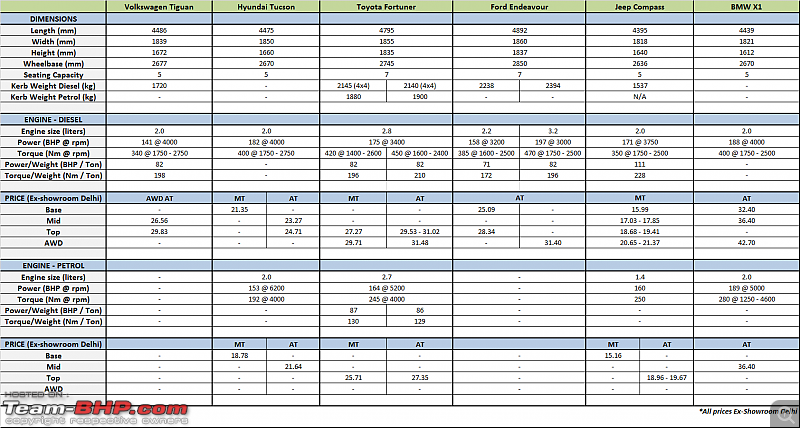 The Tiguan uses the Volkswagen Group's MQB platform, which it shares with the Audi A3, Skoda Octavia & Superb. This platform also underpins the new Skoda Kodiaq SUV, expected to be launched later this year. The Tiguan measures 4,486 mm in length, 1,839 mm in width and 1,672 mm in height. It has a wheelbase of 2,677 mm and a laden ground clearance of 149 mm. Like most Volkswagen cars, the Tiguan has a classic, elegant European design. While it has stronger character lines than say a Jetta, it is still an understated design with no overdone styling cues. It appears timeless and is likely to age well. The car looks contemporary enough, but it won't stand out in traffic. The Tiguan is still more of a crossover than a full-sized SUV and does not have the presence of a Toyota Fortuner. The fit & finish are very good with tight and uniform panel gaps all over. Like most German vehicles, the Tiguan feels solidly built. However, being based on the lightweight MQB platform, it does not feel quite as sturdy as the erstwhile Jetta. The car has a kerb weight of 1,720 kg and this is evident when you try to lift the bonnet or open the doors. The doors shut with that typical thud that we have become used to in European cars. No rattles are heard anywhere and there is barely any flex in the metal if you try to press it with your thumb. The paint job is top notch as well - typical Volkswagen. Coming to safety, the Tiguan is equipped with six airbags, 3-point seatbelts for all occupants, ABS + EBD, ISOFIX child seat mounts, self-sealing tyres, traction control, electronic stability control, hill descent control and a driver alert system among others. The car scored a 5-star rating in Euro NCAP crash tests and was rated Best in Class and Best Small Off-Roader of 2016 by the same organisation. Like other cars from the Volkswagen stable, the Tiguan comes with a standard warranty of 2 years / unlimited km, which can be extended for another 2 years. Classic Volkswagen face will appeal to those who like an understated design. Use of chrome is subtle & elegant: 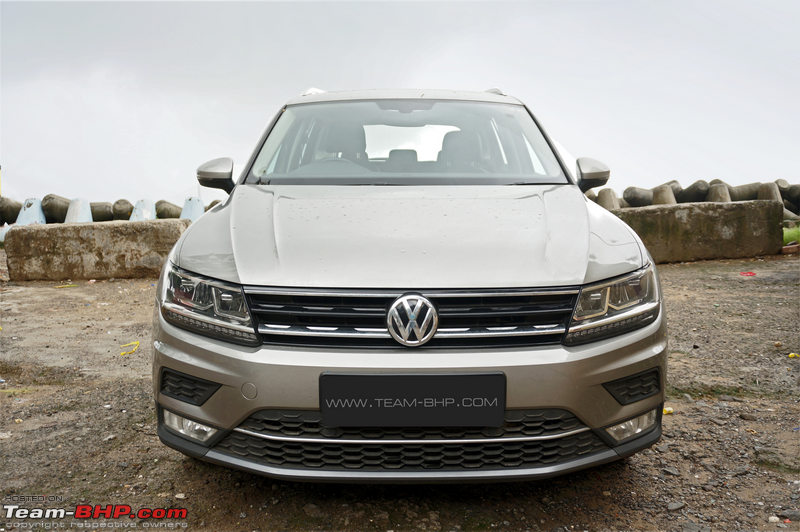 Rear end design is boring, even with the sharp character lines and creases. Like the front, there is subtle use of chrome: 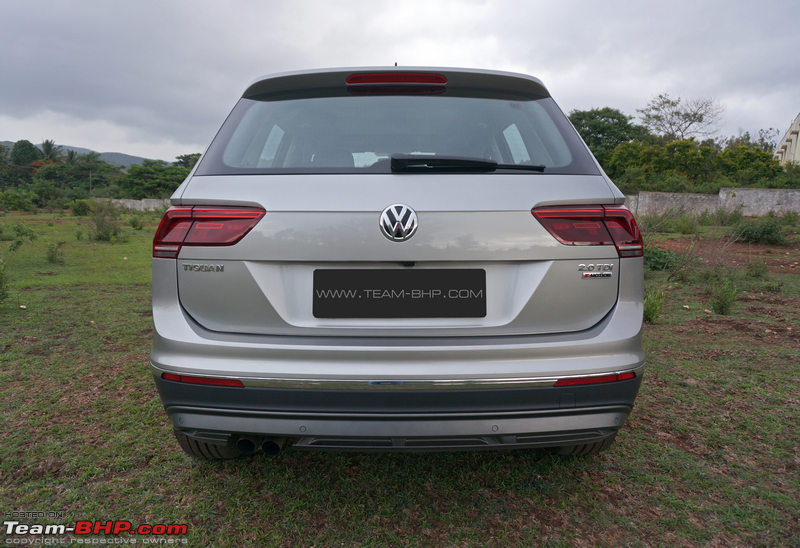 The Tiguan's design has excellent proportions. The wheel wells are perfectly sized with the right amount of muscular flare. The roof rails and the plastic cladding all along the sides as well as around the wheel arches give the Tiguan a crossover look:  The Tiguan looks best from this angle. While the design is very classy, this ain't no Toyota Fortuner when it comes to street cred or presence:  Viewed from this angle, the Tiguan looks more like an SUV, thanks to the 'boxy squared off' design. Build quality is very good all round: 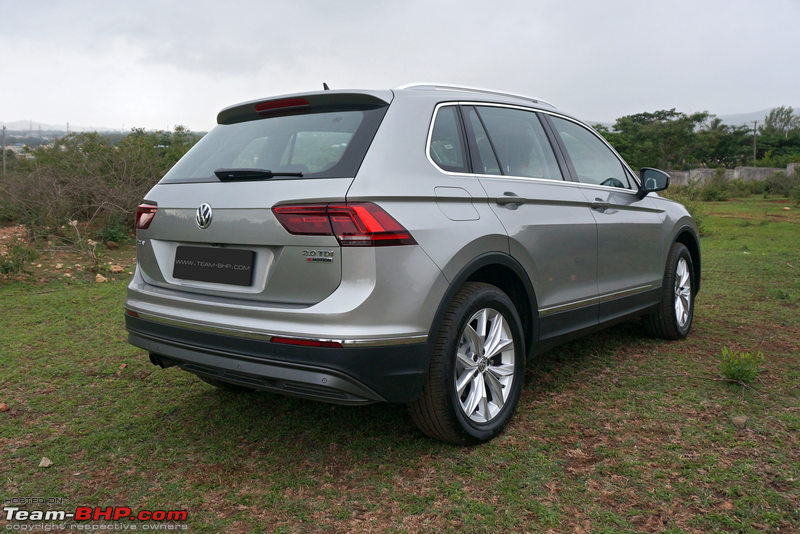 All-LED headlamp clusters look stunning. They have daytime running lights with chrome inserts surrounding the LED reflectors. Auto Headlamps are self-levelling along with coming home & leaving home functions. Notice how the horizontal chrome slats on the grille merge with the chrome inserts in the headlamp cluster: 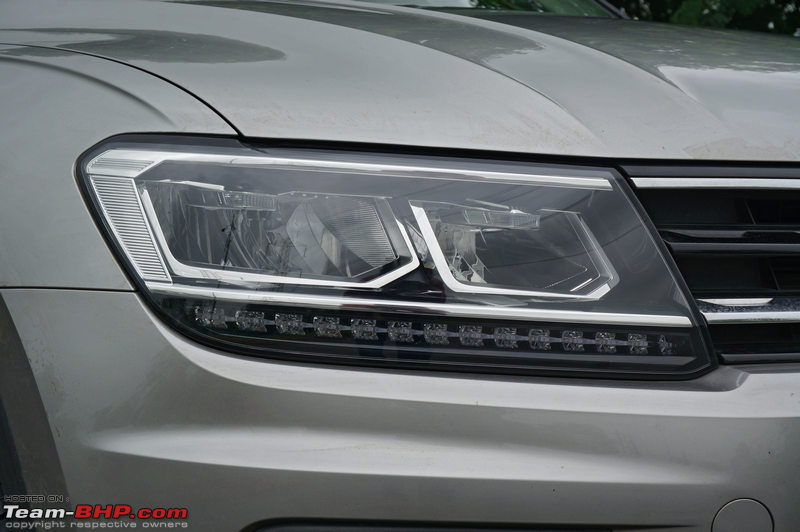 With all the lights in action. The daytime running lights also function as the headlights. Turn indicators are located below:  DRLs are bright & prominent, even during the day: 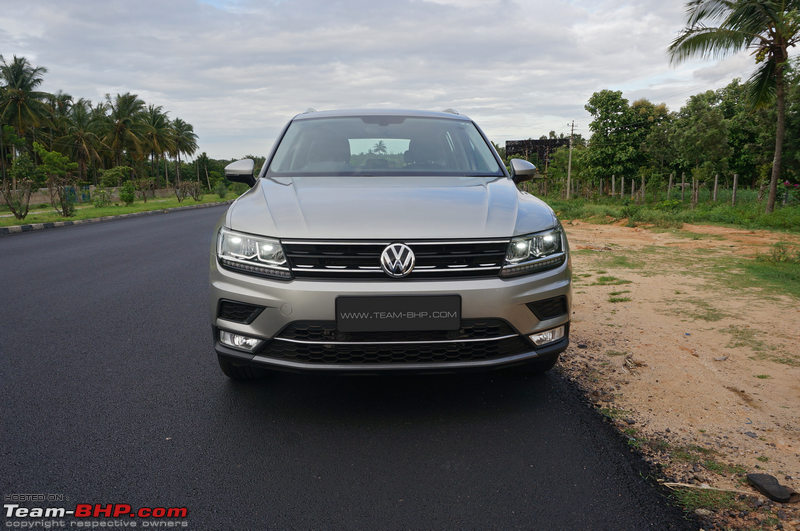 Grille is finished in a glossy black with a chrome strip on the top and middle slat. Big and prominent VW badge sits in the middle:  Front bumper bulges out at both the ends. It houses a large air dam, four parking sensors (beautifully concealed) and the foglamps:  Wide air dam has a honeycomb mesh grille with a chrome strip running horizontally across. Condenser is clearly visible behind it. Lower lip of the air dam is finished in grey and forms a scuff plate below:  Front corner parking sensors are hidden in black plastic with a honeycomb mesh design pattern. Foglamps are located lower down on the bumper. They are halogen units and double up as cornering lights. Slot to attach tow-hook is located on the front-right of the car:  Underbody gets a good deal of protection at the front. Considering the conditions of roads in India, this is a must-have on expensive cars: 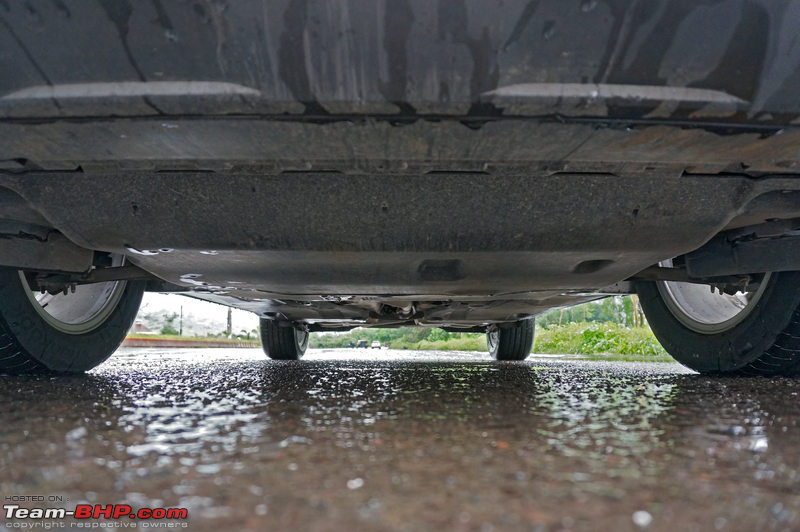 Large bonnet has four prominent creases. Notice how the outer crease merges with the headlamps: 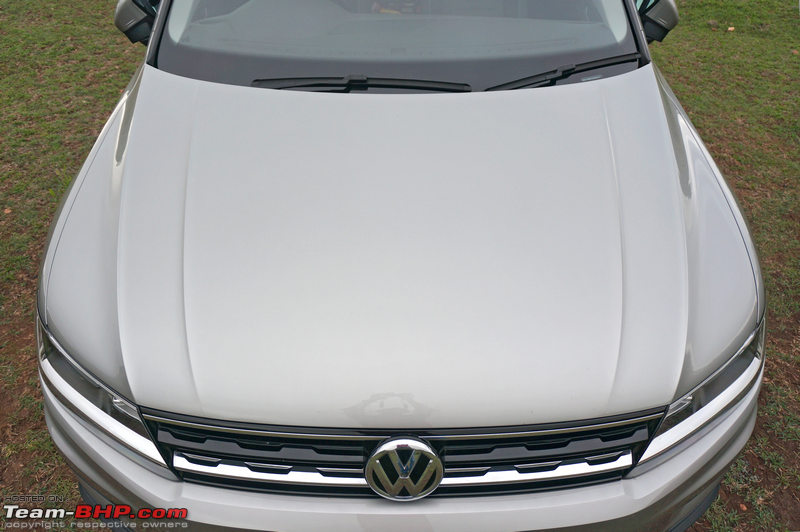 Windshield washers neatly concealed under the bonnet: 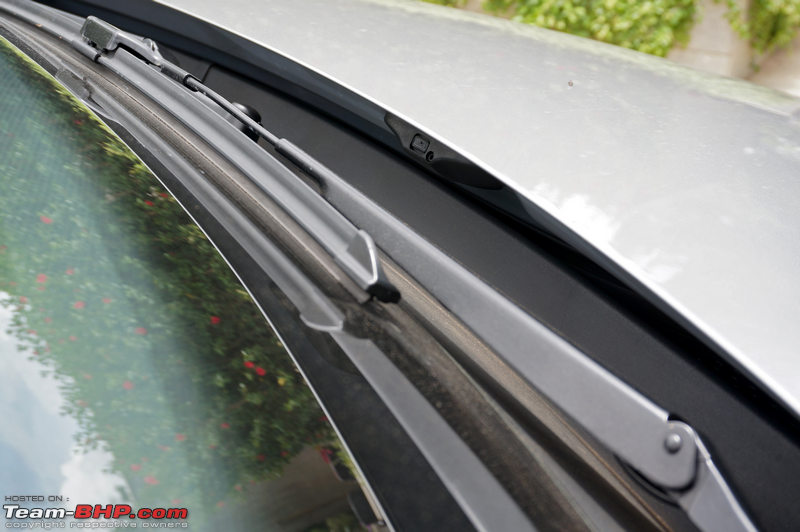 Windshield washers squirt out effective sprays (rather than jets) of water. The big wipers have a good sweep: 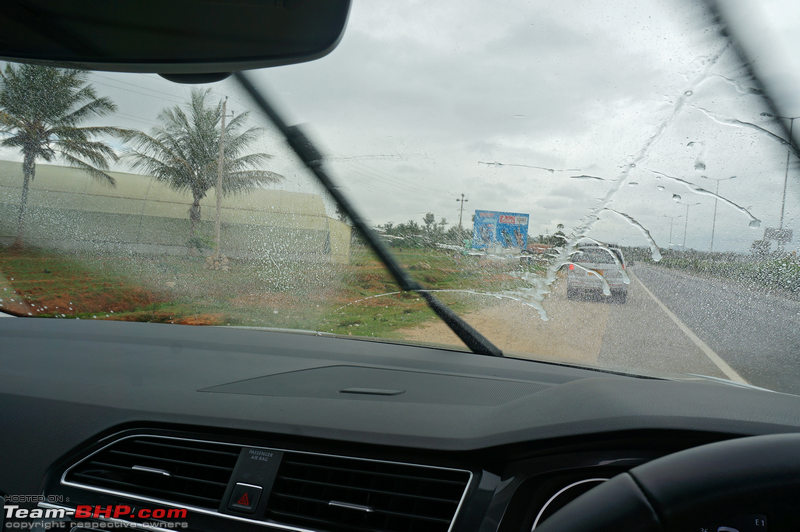 Panel gaps are tight and uniform for the most part:  Flaps ahead of the front wheels aid aerodynamics:  Full cladding in the front wheel well… 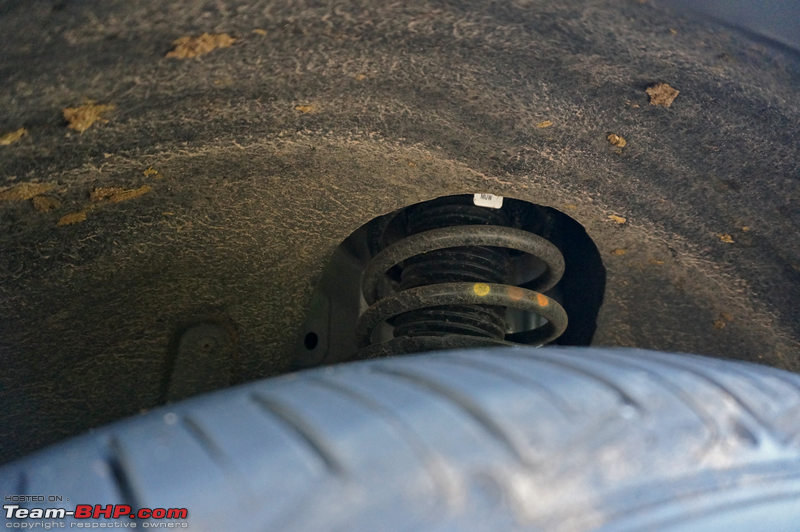 …as well as the rear: 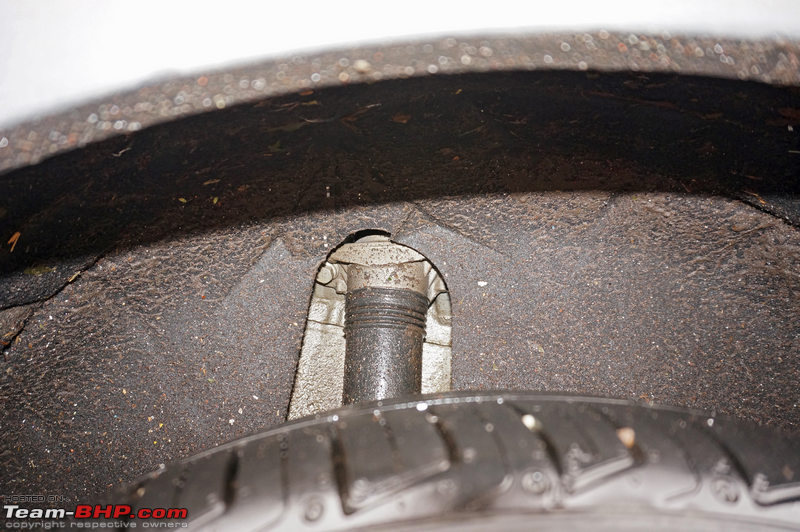 Highline gets 18" alloy wheels shod with 235/55 section Hankook Ventus S1 Evo2 tyres. They provide good grip even for spirited driving, but have a harsh ride (rear passengers will feel it the most). The tyres are self-sealing, which means there is a liquid sealant inside the tyre which fills the leak when there is a puncture. This sealant takes care of most punctures, reducing the chances of getting a flat tyre while driving. Do note that 18" tyres won't come cheap when replacing. The Comfortline trim gets 17" alloy wheels with 215/65 section tyres and lacks the self-sealing tech:  The wheel-tyre combo fills up the wheel wells nicely. Disc brakes are provided on all four wheels of the Tiguan. Stopping power is good and inspires confidence in the driver: 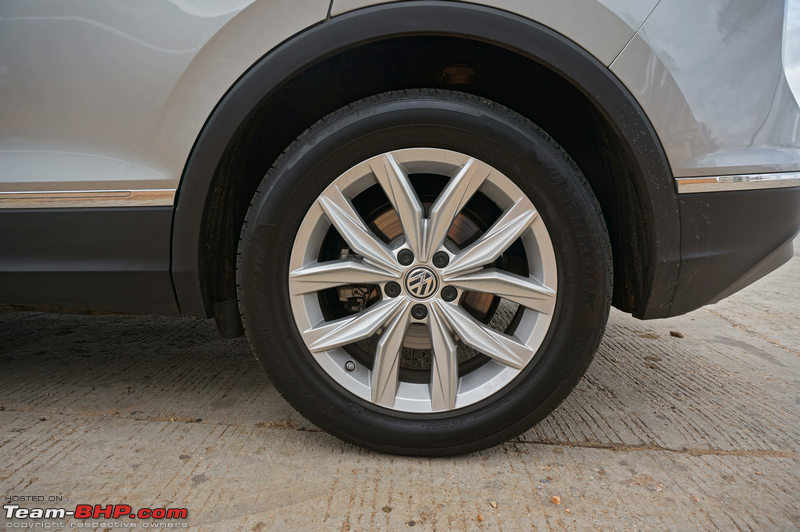 Like the front, there are flaps ahead of the rear wheels as well: 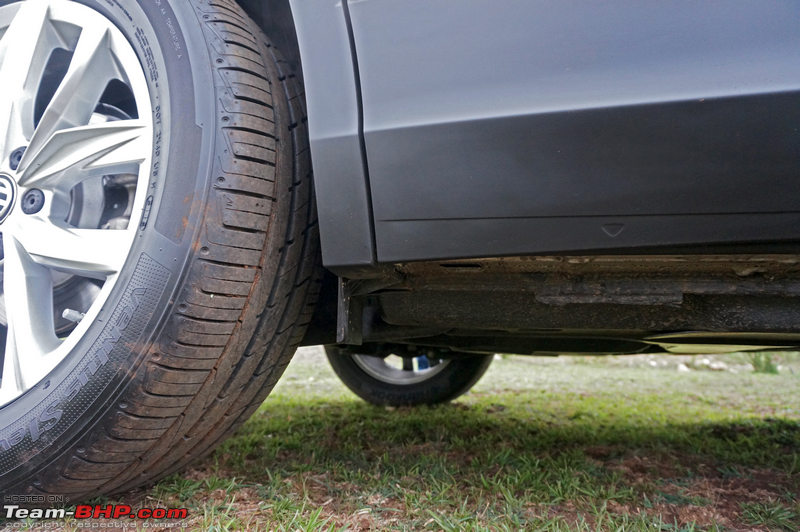 ORVM with integrated turn signal. They are electrically adjustable & foldable and automatically fold / unfold when the car is locked / unlocked respectively: 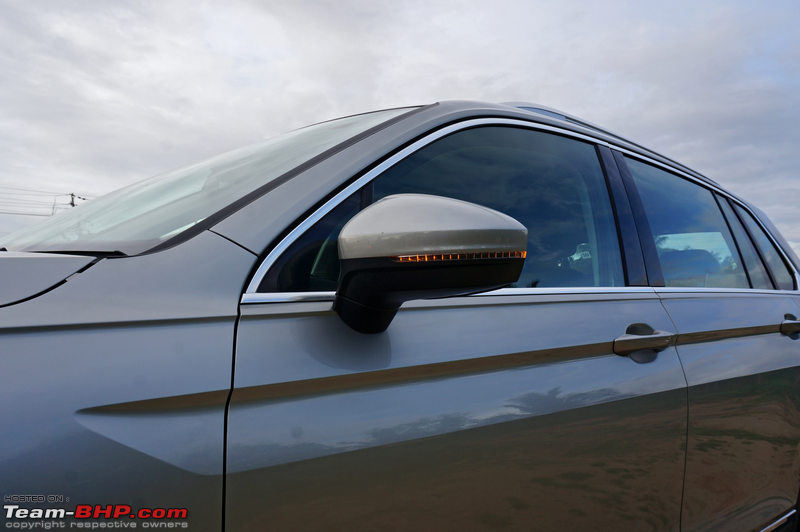 Door handles are long. Request sensor is a slim soft touch design, unlike the black physical buttons seen on other cars. Passenger door gets a request sensor as well: 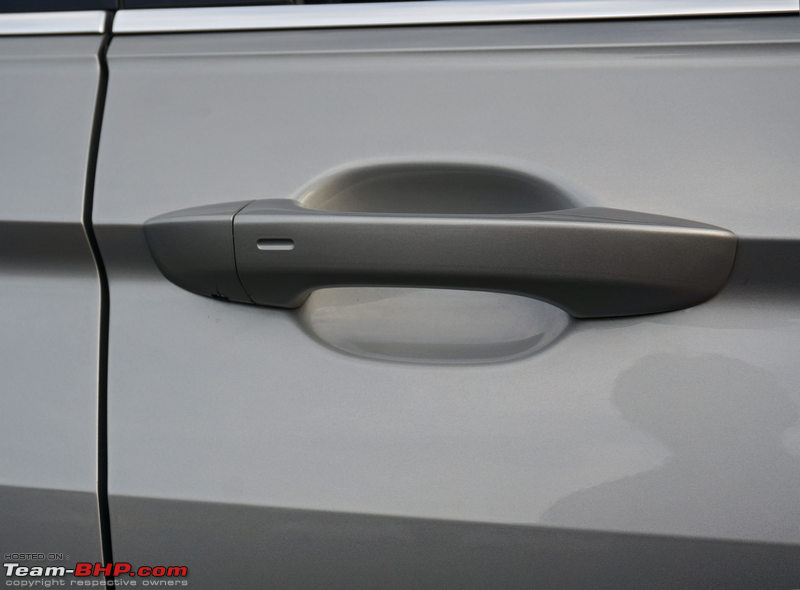 Strong character line runs high along the sides of the car from the front fender, all the way to the rear tail lights: 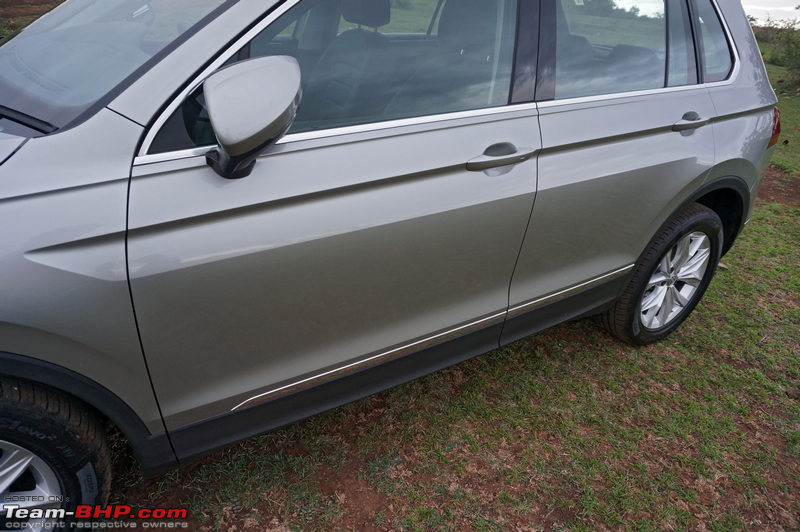 Chrome strip just above the plastic cladding on the doors is subtle, but could have been left out IMHO: 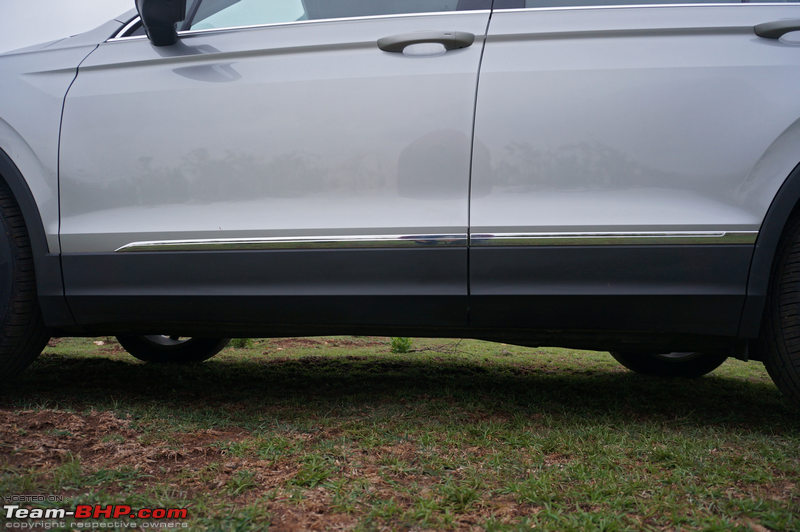 Large glass area allows a good amount of sunlight to enter the cabin. The Tiguan gets heat insulating glasses for the windows and windshields as standard. B & C-pillars are blacked out. Notice how a thin chrome border surrounds the greenhouse: 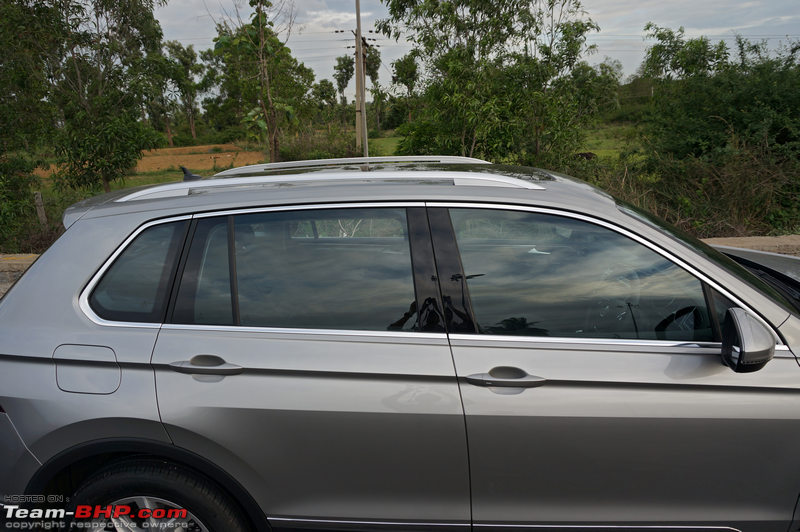 Highline gets a panoramic sunroof. Only the front half opens outwards. Metal roof rails feel sturdy and are firmly attached. They are good enough to attach a ski rack: 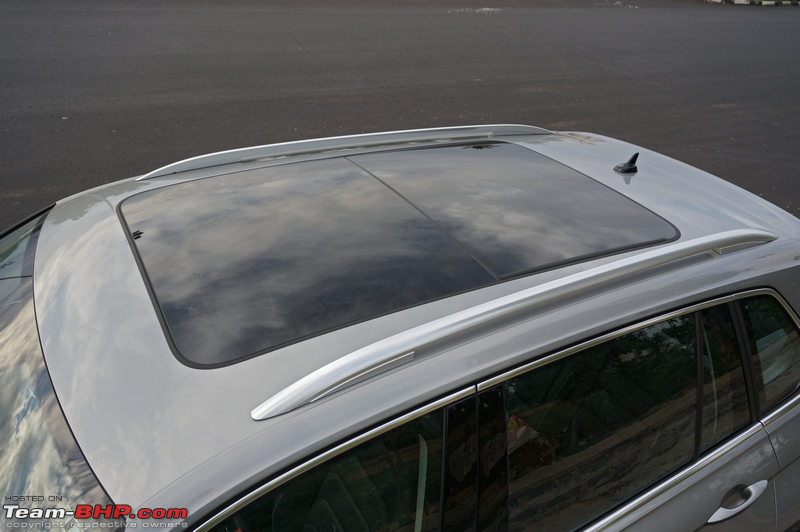 Shark fin antenna sits just behind the sun roof: 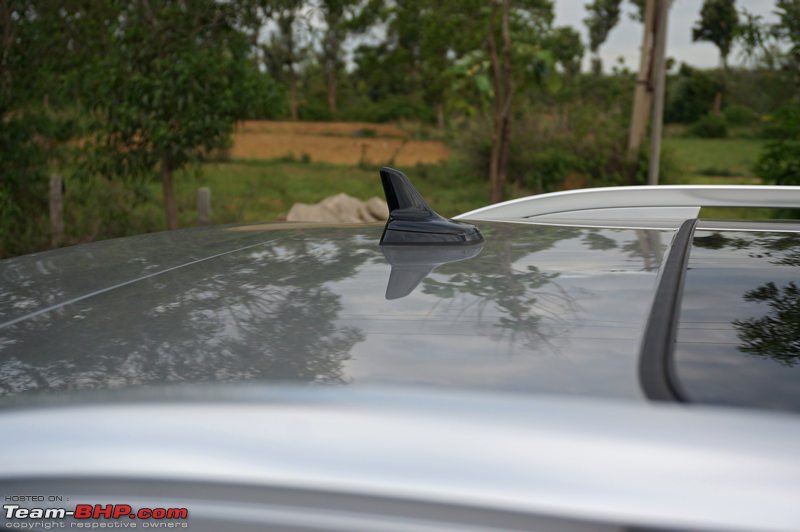 Notice how this deep chiselled out character line starts ahead of the front door and ends on the tailgate: 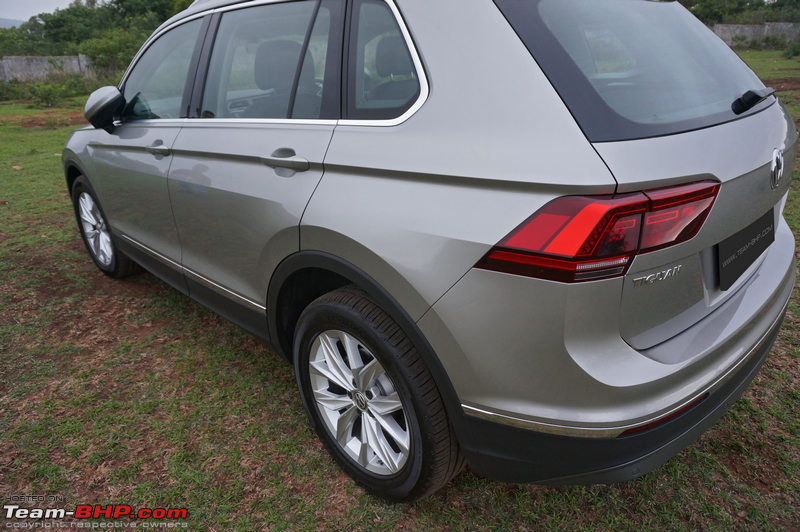 Tail-lamps have some snazzy detailing. Like the headlamp clusters, they are all-LED units: 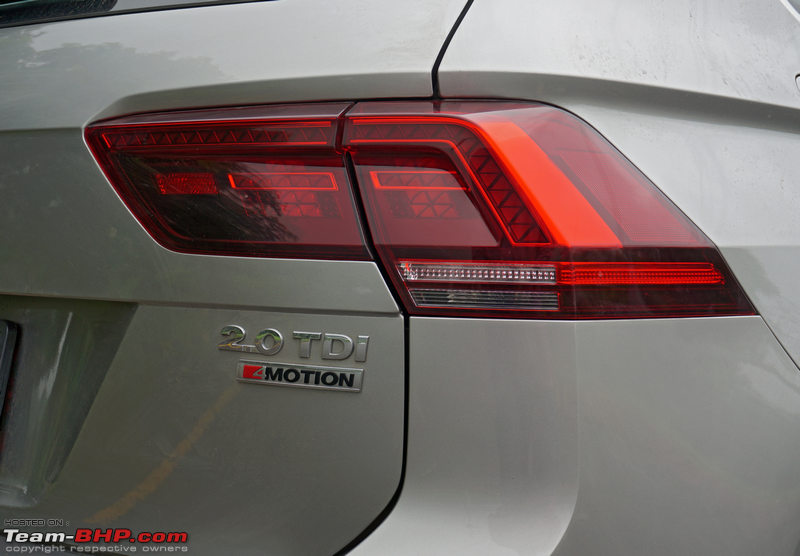 Reflectors on the side of the tail-lamp cluster: 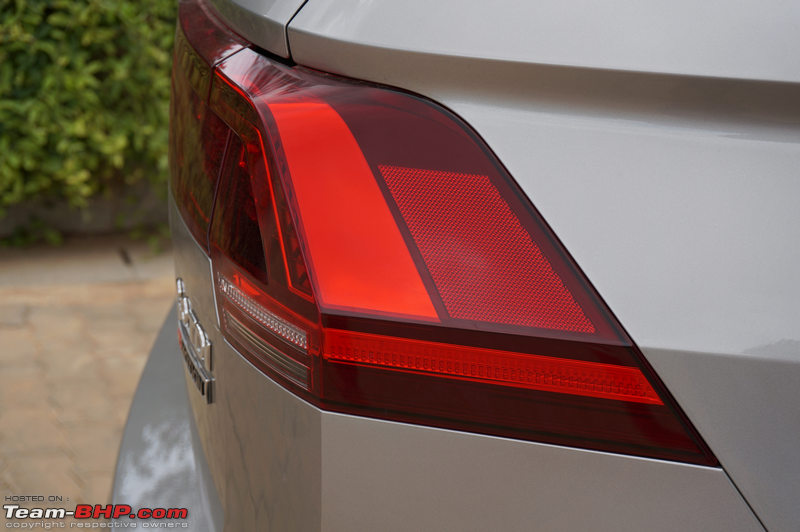 With the parking lamps in action. The brighter light on the inner part of the right-hand side cluster is a rear foglamp. The left cluster does not have this foglamp. When the boot is open, the lights on the tailgate go off. They come on again when the boot is closed  . Got to love this kind of attention-to-detail: . Got to love this kind of attention-to-detail: Turn indicators and reversing lights are located on the outer corners of the tail-lamp clusters which don't move up with the hatch:  Chrome Tiguan badge on the left side of the tailgate:  2.0 TDI badge on the right of the tailgate denotes the engine powering the Tiguan. 4MOTION badge tells us this has all-wheel drive:  Subtle roof-mounted rear spoiler houses the high-mounted stop lamp: 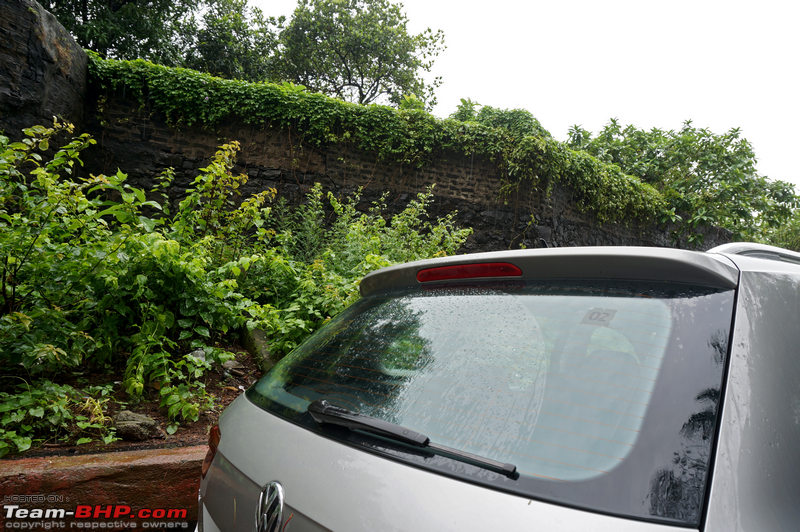 Tiny rear windshield washer is integrated in the stop lamp and sticks out very slightly:  Thin character line runs between the two tail-lamps: 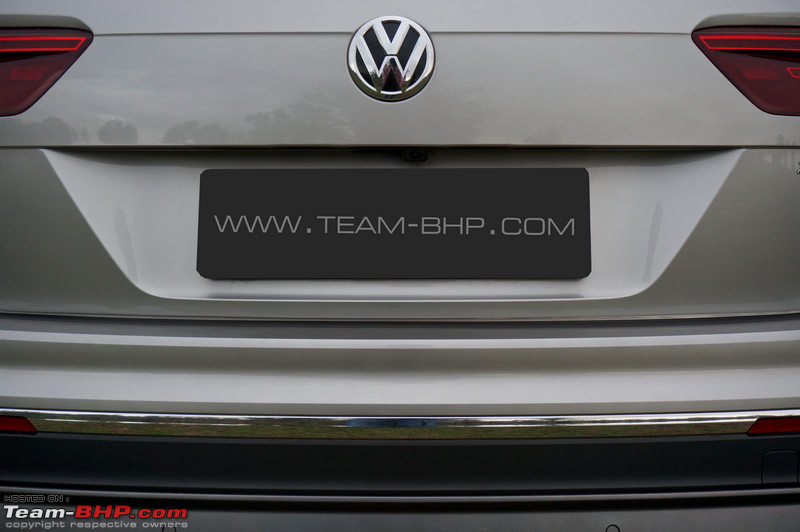 Reversing camera is neatly integrated and located just above the number plate, to the right of the electromagnetic boot release. Considering the poor rearward visibility of the car, you will need to use the camera more often than not:  Rear bumper has multiple cuts and creases and rises all the way up to the tail-lamp clusters. There is a chrome strip running across, separating the black plastic below it from the body coloured section of the bumper. The lower edge is finished in deep grey. A plastic cover for the slot to attach the tow-eye is located on the right. Four parking sensors - two in the middle and two at the sides of the bumper. Along with the reversing camera, these help greatly when parking the car. The lowest part of the bumper appears to form a diffuser and features a cut-out on the left for the exhaust pipe:  Slim and long reflectors are integrated into the chrome strip on both sides: 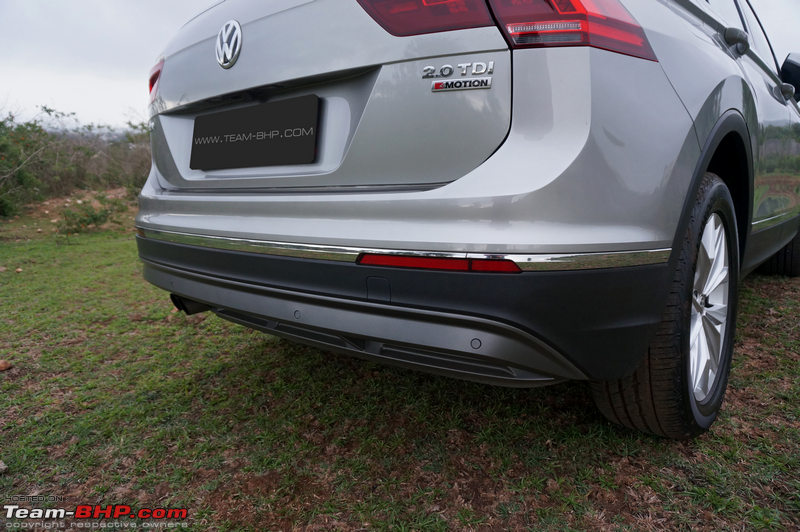 Twin exhaust pipes peep out from the left. Note the sophisticated multi-link suspension at the rear:  With one of the best-selling SUVs in the country. The Tiguan is definitely a size bigger than the Creta, but the understated design might see it getting lost in the crowd. Most people will find the styling to be too understated / boring - it's got no 'wow' factor at all: 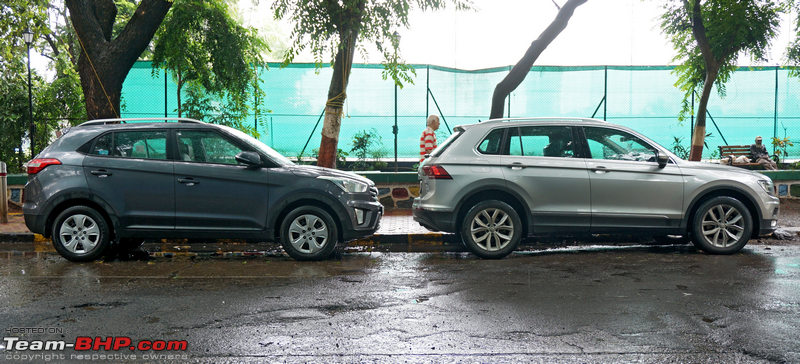 Last edited by Aditya : 24th September 2017 at 19:27. |
| |  (46)
Thanks (46)
Thanks
 |
| The following 46 BHPians Thank Aditya for this useful post: | akshay81, anukritbhargava, Ashutosh, Avikbrio, Biohazard, blackwasp, CarguyNish, carrazy, Col Mehta, deetjohn, ecosport rules, Geo_Ipe, graaja, GTO, hemanth.anand, iliketurtles, InControl, Jaggu, Keynote, lemedico, libranof1987, lokii_83, MadSnapper, mbz180, neil.jericho, Obi-Wan, phoenixash, RaghuVis, RavenAvi, Reinhard, RoverX, Scorpion 10, Simat, Simhi, SourabhSuresh, sparky@home, sri_tesla, suhaas307, sunny29584, theexperthand, timuseravan, uday.ere, vb-saan, Vid6639, Vik0728, vredesbyrd |
| | #4 |
| Team-BHP Support  | Interior - Front  The Tiguan feels heavy and solid the moment you open the front doors. They open and close with a three-stage action and shut with a typical 'European thud'. Getting in or out of the car is easy, unlike in tall body-on-frame SUVs (e.g. Fortuner). The Tiguan isn't a very high crossover, neither is it low slung like the GLA. Ingress is very easy thanks to the door sills that aren't very wide and seats that are placed at a comfortable height. The high roof helps matters as well. Once you step in, VW owners (especially Jetta owners) will feel right at home. The design, switchgear and controls are typical VW. The Tiguan gets an all-black cabin. Beige lovers will be disappointed as it doesn't have the same luxury quotient, but the dark shade will help the interiors age well and keep them from getting soiled or mucky over the years. Even with the black interiors, the Tiguan's cabin feels airy, thanks to the light grey pillars, roof liner, panoramic sunroof and large glass house. The cabin's width also ensures that front seat occupants don't feel too close to each other. The interior design is understated and classy. There are silver, glossy grey, piano black and leather inserts at various places on the dashboard, center fascia and doorpads. The Tiguan is loaded to the gills in terms of interior goodies such as electric seats with memory presets, ambient lighting, 3 zone climate control, auto headlamps, auto wipers and an 8" infotainment system with Android Auto and Apple CarPlay. All of this lends a very premium feel to the cabin. The dashboard is functional and very well put together with excellent fit & finish in general. Plastics on the upper half of the dashboard and on the front fascia surrounding the infotainment system are soft to the touch. Those below are hard, but of good quality. The switches feel durable as well. All the controls and switches have that satisfying 'click' when operating. There are no visible rough edges anywhere in the cabin. Interior has an understated and elegant design. The quality of materials used is way better than any other SUV in this price bracket (like the Endeavour or Fortuner). Everything feels well put together. The cabin offers sorted ergonomics, good space, lots of storage and many likeable features. You'll be at home within minutes of stepping inside this user-friendly cabin. That said, the cabin has no wow factor, something that is typical of most VW's: 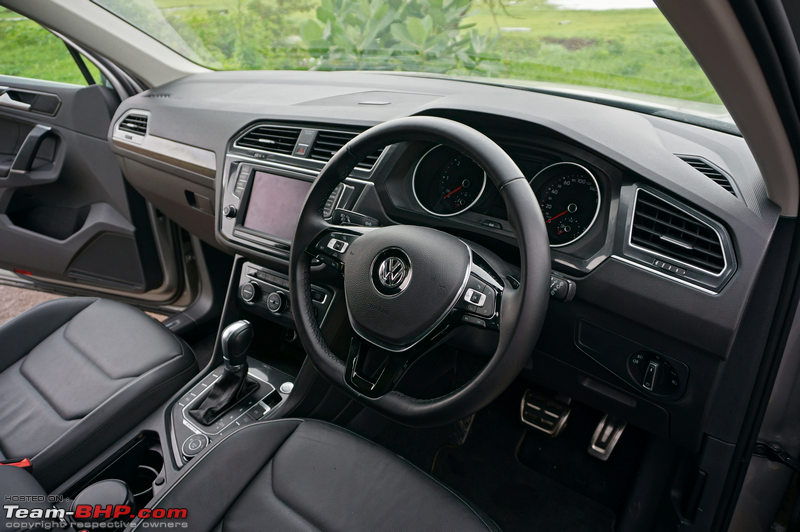 Frontal visibility is excellent. You sit higher up than a sedan, but not as high as a Fortuner or Endeavour. You can see a fair bit of the bonnet from the driver's seat. However, you cannot see the end, as the bonnet slopes down sharply:  There's a small front quarter glass inside the window frame itself and not on the A-pillar. It's small and not really useful in terms of visibility as the ORVMs block the view. This small partition is actually done to reduce the size of the front window so it can go down all the way:  Steering wheel is identical in design to the Vento, Ameo and Jetta, but sports more buttons. It's amongst the best wheels to hold on to that we've seen. Flat-bottom steering gets leather, chrome accents and piano black panels for a premium look. It's chunky and a delight to grip with the contours for your fingers. Hornpad will be a stretch for those with small hands. It's not easy to press either:  Left spoke houses the controls for the cruise control and the volume for the audio system. For the cruise control, using the + or buttons on the left-hand side of the steering wheel changes values by 10 units. Telephony controls and buttons to scroll through the MID's features are located on the right spoke. Lower left button is for voice commands. At the bottom are the buttons to change the track playing on the audio system: 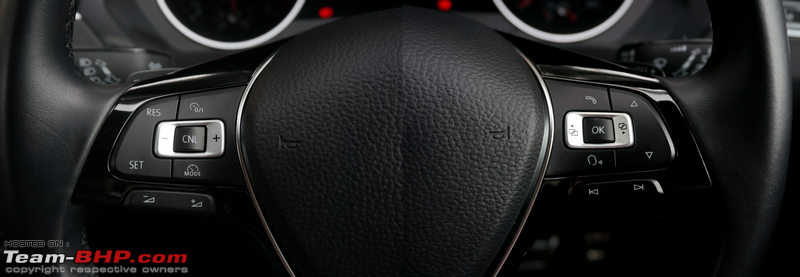 Paddle shifters on either side of the steering in black - one on the left is for shifting down and vice versa. While the shift time is decent, they don't feel meaty, and have a clicky feel:  Paddles are nicely contoured for your fingers to fit in:  Zooming in to show you the high-quality leather stitching on the wheel:  Steering offers tilt & telescopic adjustment. Both have a healthy range:  Instrument cluster consists of a tachometer on the left and speedometer on the right, with an MID in the middle - just the way we like it. Both dials get a chrome outline. Analogue temperature and fuel gauges are lodged inside the tachometer and speedometer respectively. Reset button for the trip meter is located at the base of the instrument cluster: 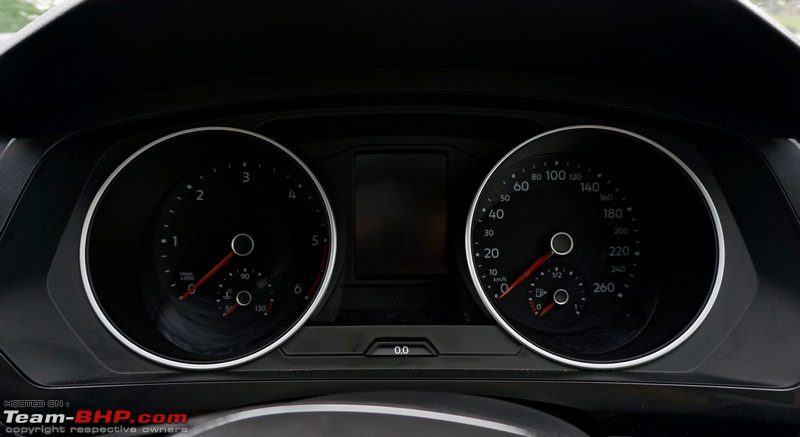 The dials are backlit in white and the needles in red. The dials are easy to read even under direct sunlight:  The well-sized colour MID. Readouts include time, temperature, gear position, odometer, trip meter, distance to empty counter, average fuel economy since start or refuel, real time fuel economy (real-time shown graphically here), average speed, real time speed, travelling time and distance travelled (since start or refuel): 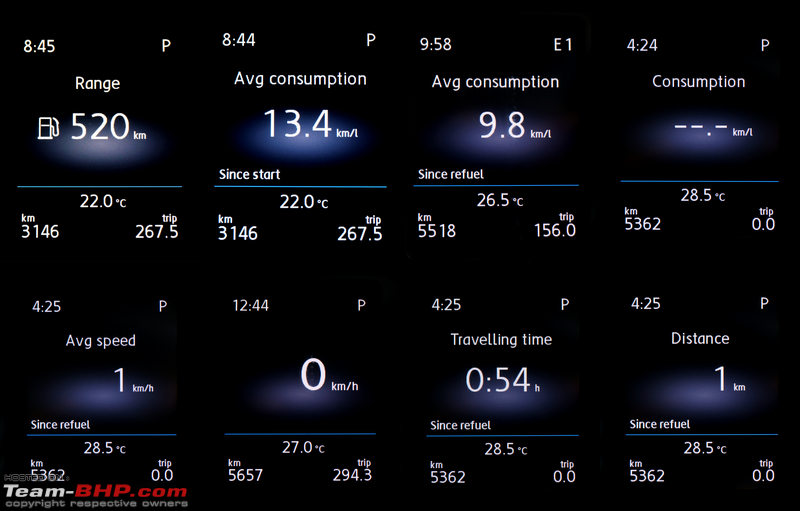 One can also use the MID to set a speed warning and check how much fuel is being consumed by accessories like the air-con. MID also has a tyre pressure monitoring system (TPMS) that shows the actual tyre pressure as well as recommended pressure in brackets. It also displays the specific door that is open in red (including the tailgate). However, there is no such warning if the hood is open:  Other readouts include the radio station or track that is being played, smartphone that has been paired via Bluetooth, an indicator for the voice commands and the date:  Wiper and indicator stalks are similar to the ones found on the Skoda Superb. The cruise control switches have been shifted to the steering wheel, making the stalks less cluttered. Tap the left stalk softly for the 'lane change' indicator. On the right is the wiper stalk. Pushing it towards the dashboard activates the rear wiper:  Engine start/stop button is located on the center console. It's finished in brushed metal and looks classy:  Plastic panel covering the regular ignition switch has a "key drawing" engraved in it. Looks u-g-l-y. If your keyfob's battery dies down, hold it here to start the engine: 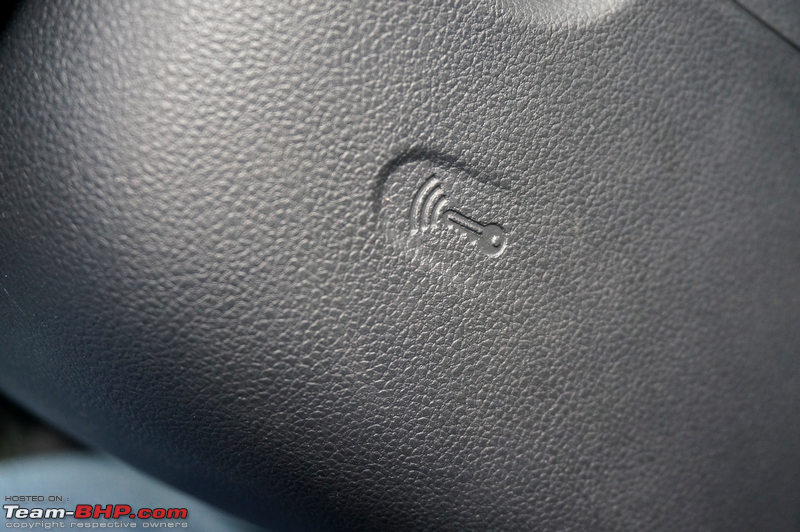 Air-con vents on the side have a thin chrome outline and glossy grey surrounds. The vents can be shut by using the knurled dial below: 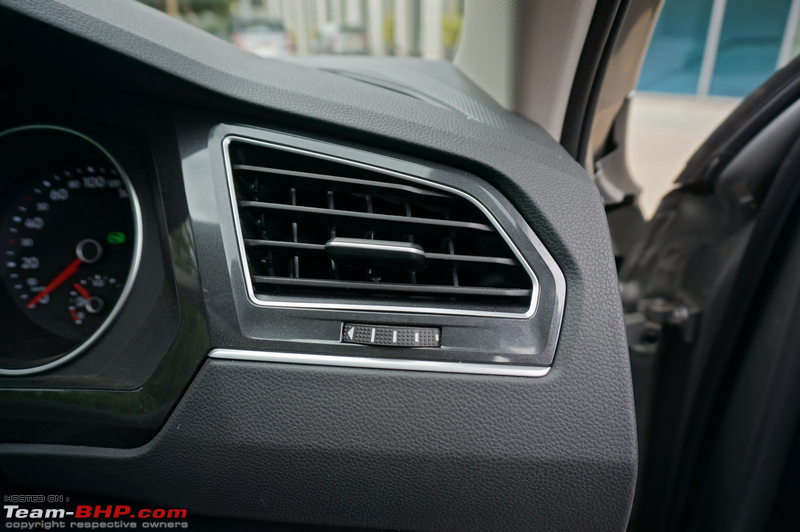 Typical European headlamp and foglamp controls. Automatic headlamps are standard on the Tiguan. Turn the switch to the parking light or headlamp position and then pull it slightly to the first step to turn on the front foglamps. Pull further to the second step to switch on the rear foglamp:  Storage compartment below the headlamp controls. Good place to dump miscellaneous stuff:  Bonnet release lever is placed on the right side of the driver's footwell. The lever is chunky and sturdy. To pull it, you need to open the door first! This is going to be inconvenient when a hotel's security guard asks you to open the bonnet for inspection:  Doors open in a three-stage action. Doorpads house the front speakers + tweeters. Quality of materials used is good:  Doorpads have silver and glossy grey insert at the top and leather on the armrest + around it. Grab handle has silver inserts at both ends. The upper half of the doorpad is made of soft touch plastic:  Door handle is finished in silver and feels sturdy. Central locking buttons are located next to it:  All 4 power windows get auto up and down functionality. Buttons are illuminated too. ORVMs are electrically adjustable and foldable, and get auto-folding function. Notice the silver inserts on the window buttons and ORVM control knob:  Boot release is located lower on the doorpad. It is essentially just a power window switch that has been rebadged, but does not have a silver insert:  Door pockets are large and have a felt lining on the inside:  They are deep and can easily hold a 1L bottle + other items:  Door sill is not very wide...a good thing. Highline gets illuminated scuff plates:  Seats are draped in Vienna leatherette. The seats are firm with excellent bolstering on the sides and offer superb support. They might be a little too narrow for the larger built folks though. They are also heated which is pointless in India (should have been cooled instead):  Driver's seat is 12-way electrically adjustable (including for lumbar support). These switches feel sturdy and durable. This, along with the adjustable steering, makes finding a comfortable driving position very easy:  The fore and aft travel range is long, like most VWs. Even tall drivers will fit in without complaint:  A look at the seat in the lowest and highest positions. Adjustment range is healthy. Headroom is excellent. At 5'10", I still had an inch of headroom with the seat in its highest position! 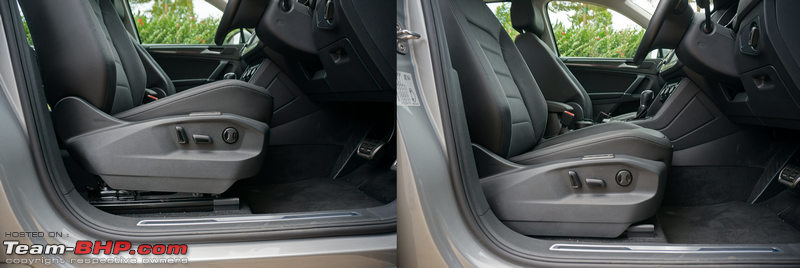 Driver's seat has 3 memory presets. Each preset stores your seat & ORVM positions: 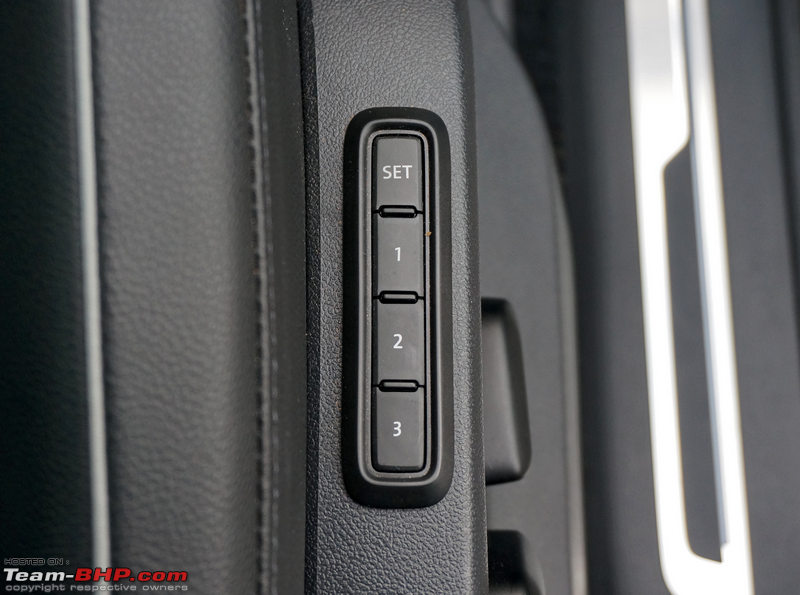 A closeup of the Vienna (fake) leather upholstery. Quality is strictly average by 30-lakh-car standards: 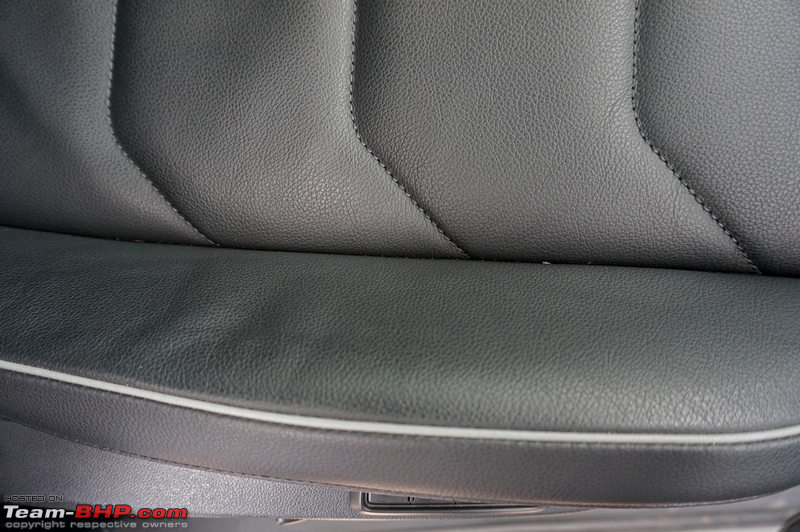 Both front seats have fabric lining on the sides: 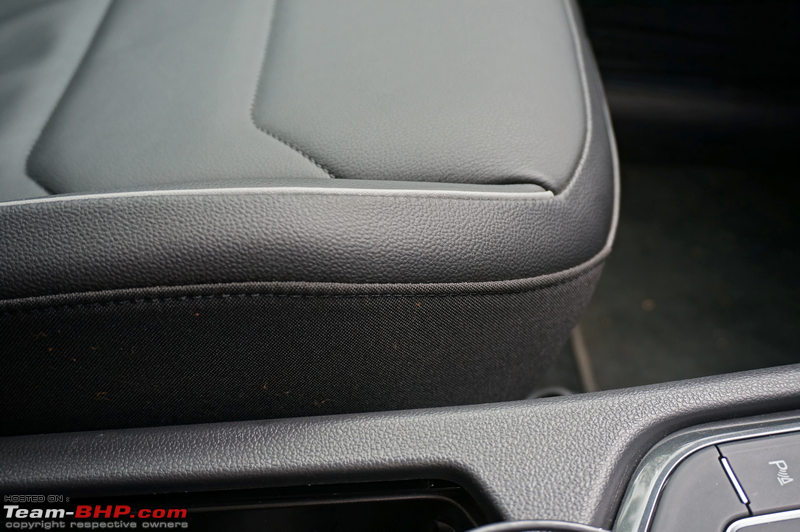 Along with height adjustment, the front headrests also get fore & aft adjustment! This is usually offered only by the big 3 German luxury car makers:  Manual adjustment for the front passenger seat. But... 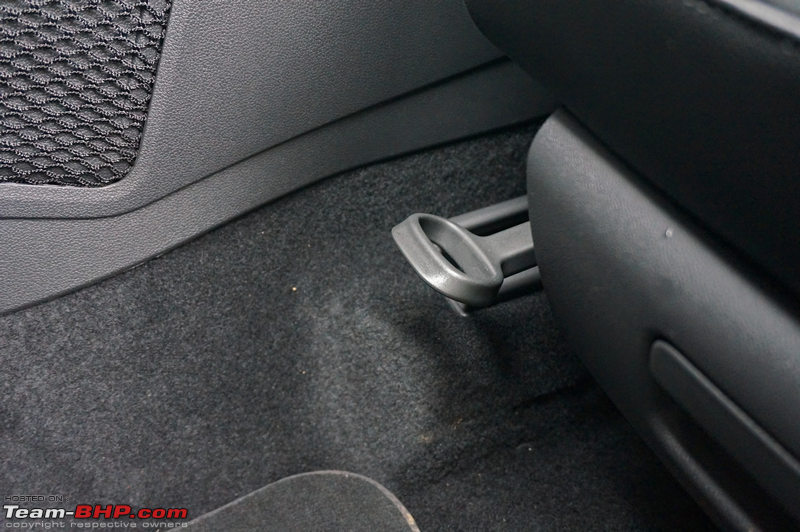 ...it gets height and lumbar adjustments!  The seat also folds down flat. This helps with long pieces of cargo or if a chauffeur-driven seth wants to chill like he's in a lounge:  Driver armrest is clad in leather and has a soft padded surface:  It slides forward and is also adjustable for height. Neat:  Height-adjustable seatbelts:  The footwell is wide enough and the dead pedal is huge! Accelerator and brake pedals are finished in aluminium, with black rubber on the surface. Dead pedal is positioned perfectly and might even accommodate size 14 shoes! Not every day that we see such a long & wide dead pedal:  ORVMs have a defogger and are electrically adjustable and foldable. They have a memory function as well. Visibility is good, but they get narrower at the end. Driver's side unit is aspherical, while the passenger side ORVM has a tilting function while reversing (to help you avoid the kerb):  Auto-dimming IRVM is wide enough to cover the entire rear windshield. Thick D-pillars and headrests hamper visibility though: 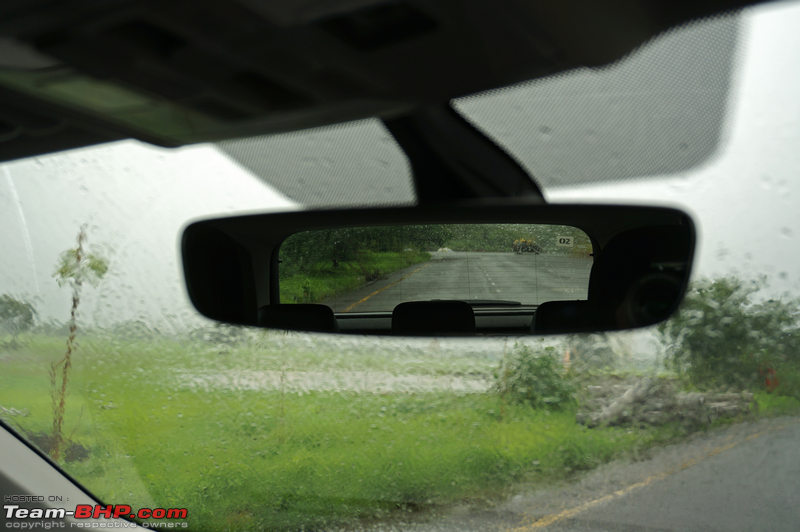 Sensor for the auto-dimming function is located behind the IRVM. The feature is on by default; you don't even have to press any 'auto' button:  Rearward view is average, like most SUVs I might add. Thick D-pillars and passenger headrests mean youll be depending on that reversing camera a lot. Watch out for bikes & low-slung cars parked close behind you:  Center fascia tilts towards the driver. The subtle use of chrome, silver and piano grey inserts gives it a classy look:  Central air-con vents have a chrome border and sit at the top of the center fascia. Air flow volume can be adjusted or turned off, if you so wish using the individual knurled dials:  All variants get an 8-inch touchscreen infotainment system. It's covered in detail in a separate post: 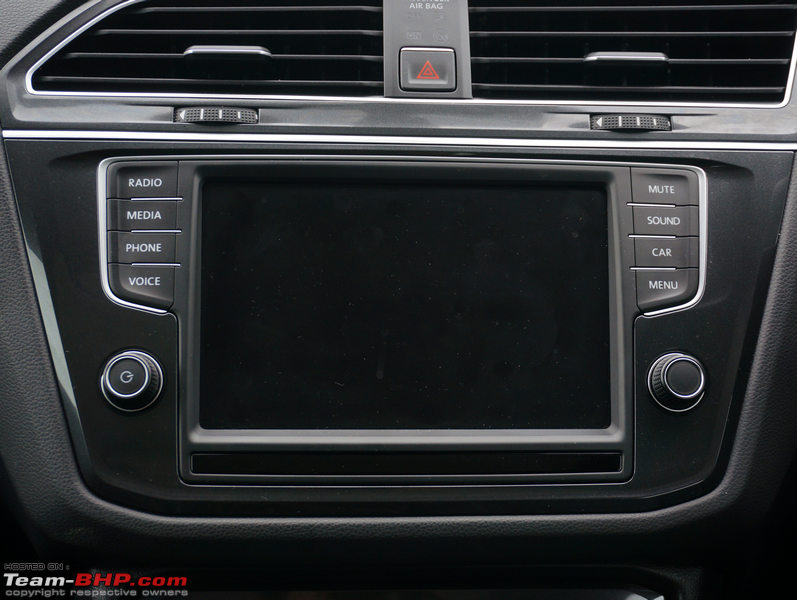 The Tiguan comes with a 3-zone climate control system. The cooling provided is average on hot days (was just about keeping us comfortable on a hot day, but didn't chill us to the bone). Rotary switches for the same are located below the infotainment system. The blower, which is controlled by using the dial in the middle, is silent at levels 1 & 2, audible at 3 & 4, loud at 5 & 6 but very loud at 7. The lowest temperature that the system goes to is 16 degrees centigrade before hitting LO, while the highest it can touch is 29.5 degrees centigrade before hitting HI; increments are in 0.5 degree levels. Pressing the 'Sync' button gets the temperature of the passenger side to the same level as that of the driver. They both can be controlled simultaneously by using the driver's side temperature knob. On turning the passenger side knob, the sync function is automatically disengaged & both get their own temperature zone:  12V power socket, Aux-in jack & a USB port located at the base of the center fascia. Shallow storage space below them has a rubber lining on the surface. You can slide your smartphone in here:  Storage space on the center console has a sweet sliding lid: 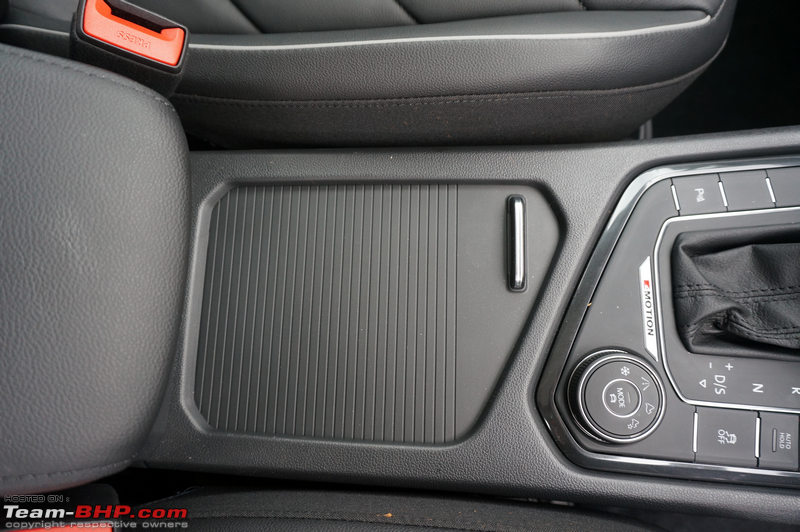 Opening the lid reveals two cupholders. While the area below the cupholders is plastic (easier cleaning), the rest of the storage compartment has a rubber base. The cupholders also have rubberised grips that prevent smaller cups from moving around. Very cool: 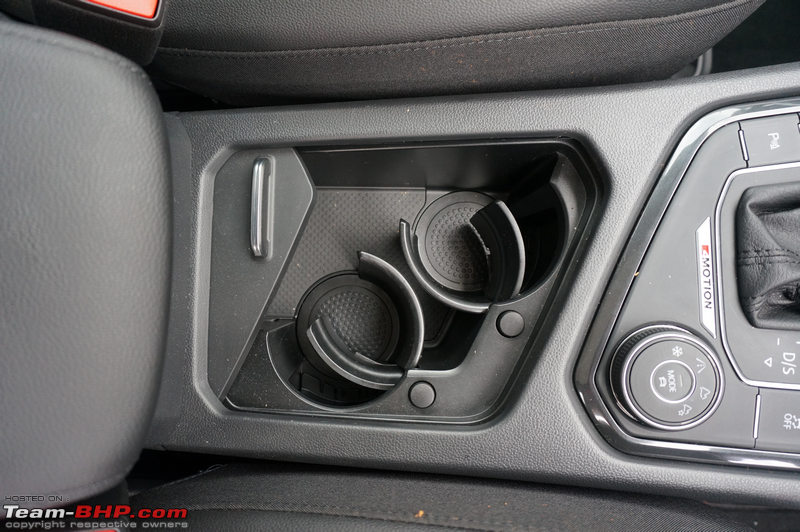 Under the driver's armrest is a fairly accommodating storage box: 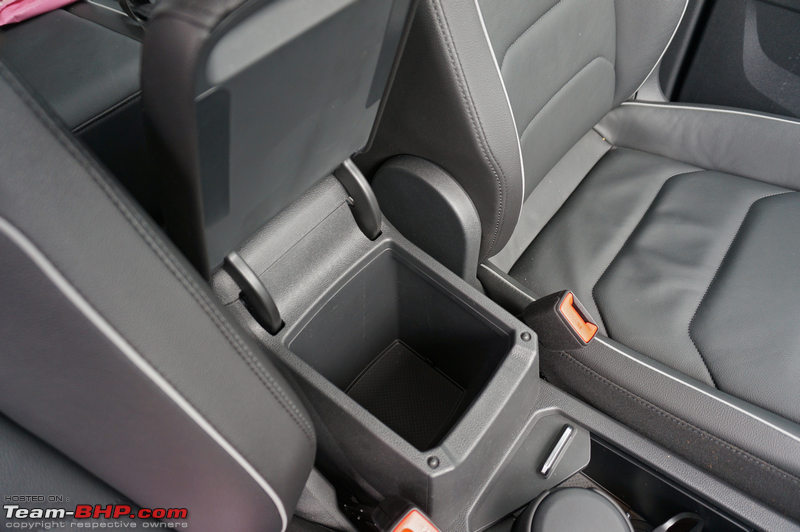 Net on the passenger's side of the dashboard can hold the odd items:  Under-seat storage drawer with a load bearing capacity of 1.5 kg. However, it does not feel very sturdy and is not very spacious either. Can barely take more than a 1L bottle - this is the max that it slides out:  Felt-lined storage compartment above the dashboard has a damped opening / closing action. One can store items the size of a wallet in it. The lid of the compartment feels cheap and plasticky. This is one of only two cheap plastics (the other one being the under-seat storage box) in an otherwise high-quality cabin: 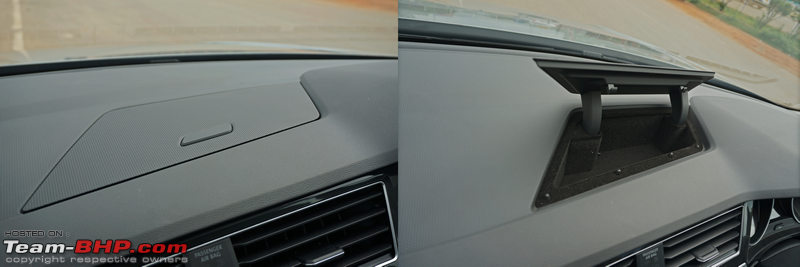 Soft opening glovebox is illuminated and quite accommodating. It has coin slots as well as a business card holder:  Glovebox has a cooling vent with a regulator to control the air flow. Turn the regulator to the left to turn it on and to the extreme right to turn it off:  Media console on the upper part of the glovebox houses only a CD / DVD player and SD card slot: 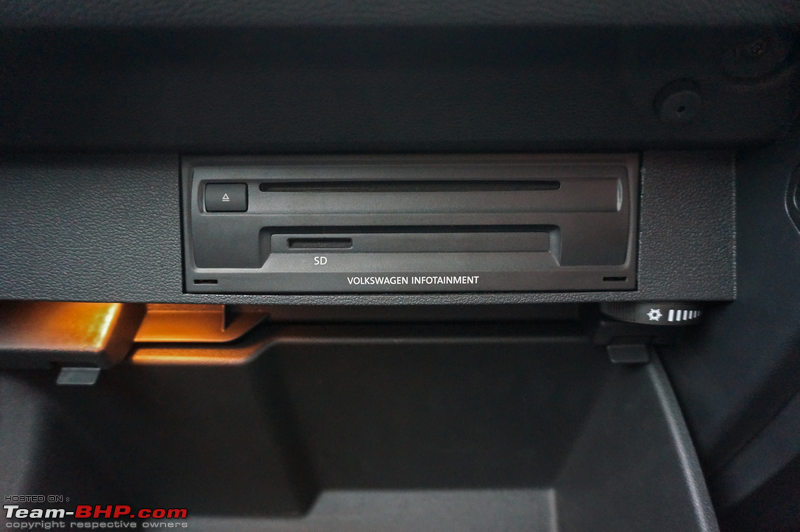 Sunvisors feel robust. Both units get vanity mirrors with illumination. As soon as you slide open the cover, the light turns on automatically. Clip for holding parking / toll tickets too:  Sunroof & cabin light controls are lifted from the Skoda Superb. Cabin uses white LEDs all round. There's a button here for the rear cabin lamp too. Bluetooth mic is integrated into the console. The two buttons at the top are used to open or shut the sunroof blind:  These are the security system's interior motion detectors:  Tiguan gets a total of 6 airbags: 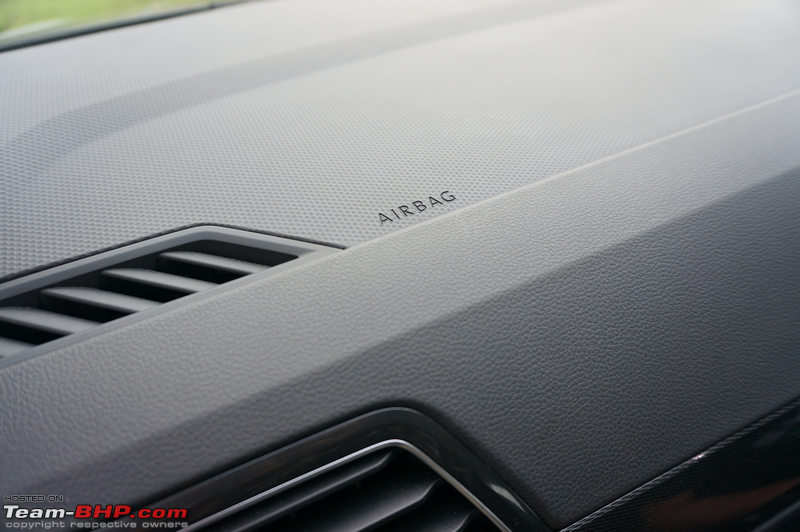 On the side of the seat... 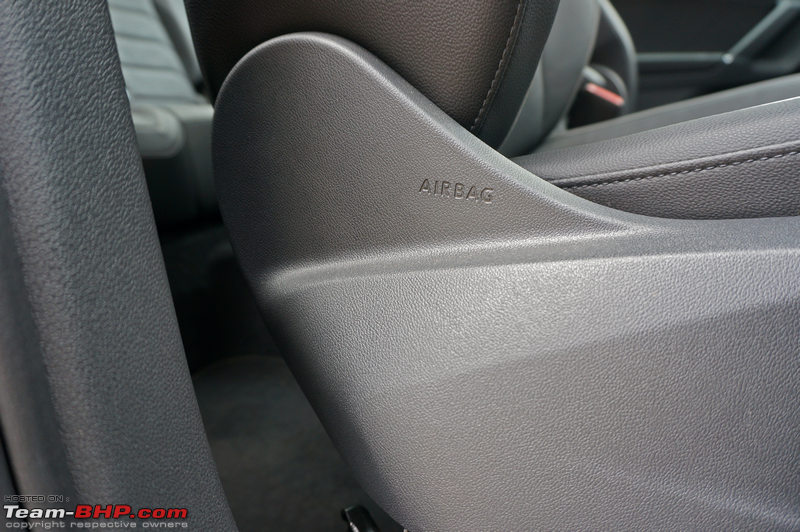 ...and B-pillars:  Disable the front passenger's airbag from the side of the dashboard. You shouldnt though children should always be placed on the rear seat: 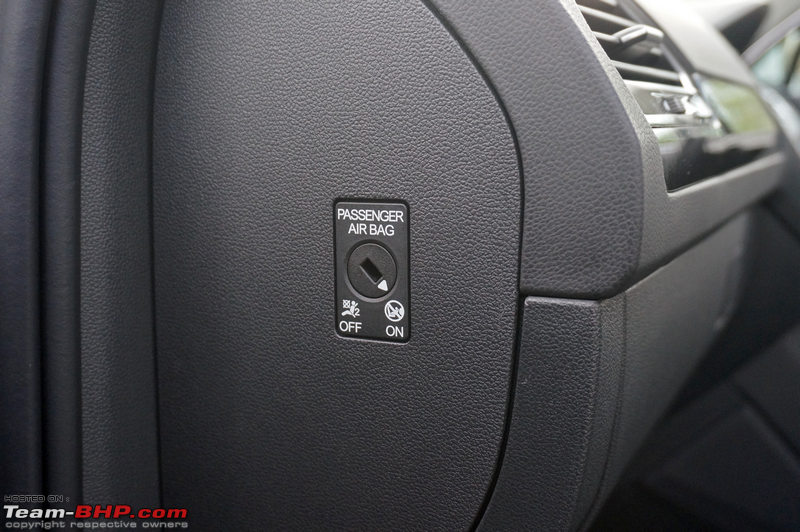 Panoramic sunroof is huge and really makes the cabin feel airy & spacious. Comfortline's cabin won't feel as nice as the interiors are black and lesser light will enter the cabin. It'll feel too dark & gloomy: 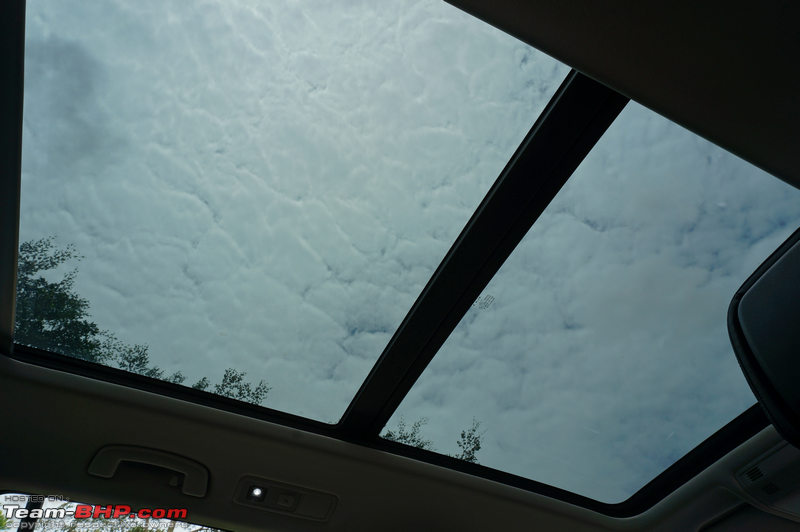 Sunroof opens outwards and goes a long way back. The wind deflector rises up when you open the sunroof to prevent wind from entering the cabin; it reduces wind noise too:  Last edited by GTO : 22nd September 2017 at 12:17. |
| |  (35)
Thanks (35)
Thanks
 |
| The following 35 BHPians Thank Aditya for this useful post: | akshay81, anukritbhargava, Avikbrio, CarguyNish, Chethan B G, Col Mehta, deetjohn, fluidicjoy, ganeshb, GTO, iliketurtles, Jaggu, Karthik Chandra, Keynote, MadSnapper, mbz180, neil.jericho, Obi-Wan, phoenixash, RaghuVis, Rajeevraj, RavenAvi, Reinhard, RoverX, Simat, SourabhSuresh, sparky@home, sunny29584, supertinu, theexperthand, uday.ere, vb-saan, Vid6639, Vik0728, vredesbyrd |
| | #5 |
| Team-BHP Support  | Interior - Rear Like the front, the rear doors of the Tiguan also open and close with a three-stage action. They open sufficiently wide and the roof of the car is high. The rear seat is also placed at a comfortable height, which means ingress & egress are easy:  Gap between the B-pillar and seat is enough to easily move your feet in & out. No silver scuff plate at the rear. Rather cheap to skip it in such an expensive car:  Door sill isn't excessively wide either, which means occupants don't have to lift their feet way over the sill when entering or exiting the car:  Like the front, the rear door pads get a silver and glossy grey insert at the top, and leather on the armrest as well as around it. However, unlike the front doors, there are no soft touch plastics at the back:  Door pockets are not as large as the ones in the front, yet they can hold a 1L bottle easily. They are felt-lined too:  Rear bench seat splits 40:20:40. Its wide enough to accommodate 3 adults. While the seat base is largely flat, the seat back has some supportive contours to hold you in place. Leather upholstery is identical to the front seats with adequate cushioning. The middle seat passenger gets a shorter seat base and a flat seat back. This frees up some knee room in between the seat and rear air con console, but the large central hump doesn't help:  Legroom is generous. Even tall occupants will be happy:  A look at the maximum and minimum legroom:  With the front seat in my driving position (5'10"), I had around 4 inches of knee room. With the front seat fully forward, the knee room was around 11 inches. If the front seats are moved all the way back, I still had an inch of legroom:  Adjustable headrests & 3-point seatbelts for all passengers  . Seat is wide and can accommodate three adults: . Seat is wide and can accommodate three adults: Both sides of the second row seat (in the 60:40 split) have fore & aft adjustment:  Travel range is superb! The difference shown here is the max adjustment range. However, because the Tiguan doesn't have a 3rd row of seats, we doubt any passenger will move his seat forward (unless it's for cargo room, but even that'll be rare):  Rear seat backs can be reclined individually. You can set it up to a totally relaxed angle or to an upright position. Under-thigh support is good. Headroom is plentiful as well. Sitting up straight, I still had more than 2 inches of room to spare:  To recline or fold the seat back forward, one has to pull this strap. This is particularly difficult for a person sitting on the seat to try & recline it. A conventional lever on the side would've been preferred:  Selective folding if you need to carry a combination of cargo + passengers. The seatback of the middle seat is connected to the left seat:  Press this button...  ...to fold the seatback of the middle seat alone. One can also gain access to the boot (from inside) by folding it:  When not in use, the seatbelt buckles can be tucked away into cavities designed in the seatbase:  Rear middle passenger gets a conventional 3-point seatbelt which is easy to use (unlike the Innova Crysta & Fortuner):  Both sides of the seat have ISOFIX child-seat anchors:  Wide center armrest with 3 cupholders (one for a small cup) has good cushioning:  Overall glass area is more than adequate, thanks to the large windows that don't swoop up like some other cars (no fluidic styling here!). There's enough light coming in at the back and even with the black interiors, passengers won't feel claustrophobic at all:  Rear windows roll down all the way:  Rear seat occupants get small fold-out trays fitted to the seatbacks of the front seats. We are not fans of these due to safety issues. When pulled out, they can puncture your chest in an accident. When folded in, they could hurt your knees. They also decrease legroom a little bit:  Both front seats get seatback pockets to dump small / loose items:  Good quality spring-loaded grab handles for all 4 doors. Both rear ones get a coat hook: 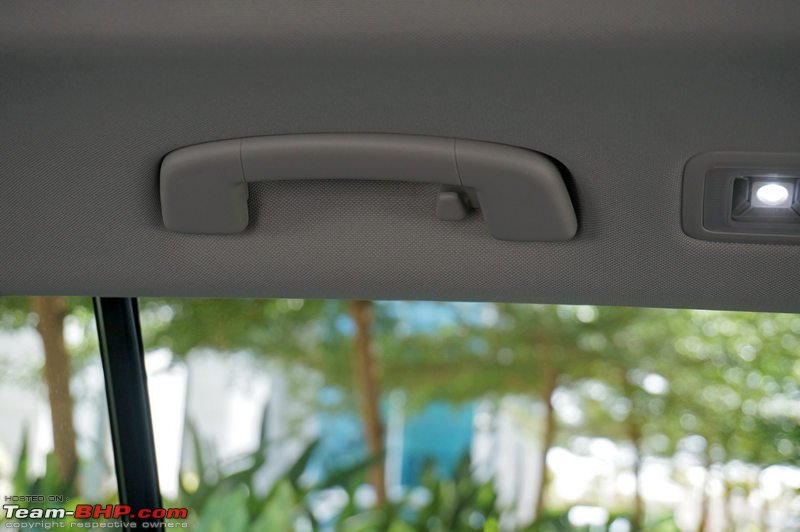 White LED reading lamps are located next to the rear grab handles:  Nifty bag hooks on both B-Pillars:  Rear air-con unit has controls for temperature, direction and air volume (manual). It also has a digital display for the set temperature: 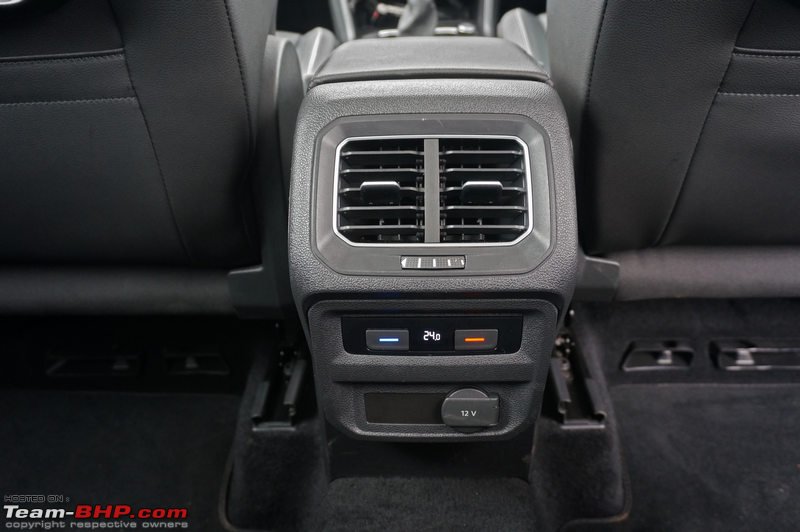 12V power outlet for back seat passengers to charge their smartphones:  Air vents below the front seats for cooling the rear passengers' feet:  Floor hump is tall and wide!! Passenger sitting in the middle will have to place his feet on either side of the hump:  Cubby holes on the sides of the rear seat can be used to keep small to medium-sized items. A 5.5" smartphone easily fits in:  Wide parcel tray comes with a prominent border. Nice quality:  At 615L, boot space is cavernous! The boot lip is not high:  The luggage compartment floor is adjustable for 2 levels:   Boot features a full carpet with no ugly bits exposed. It can easily swallow large bags when traveling or picking up someone from the airport:  Top tether for the child seat: 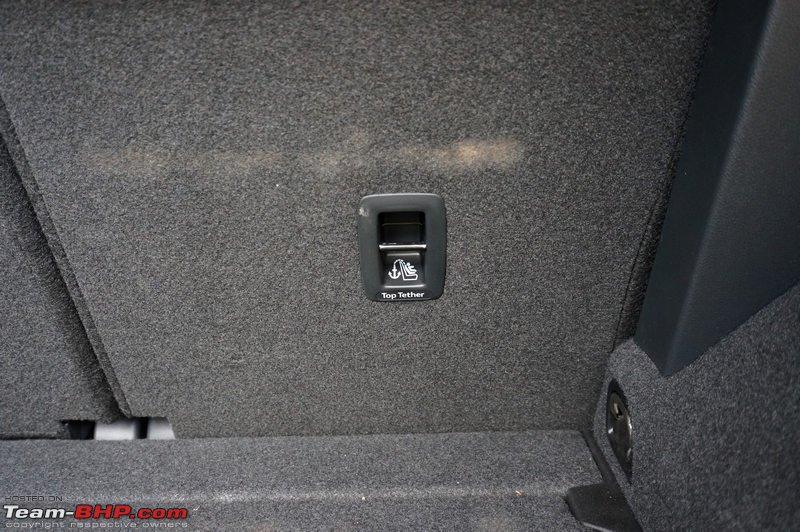 Plastic pull tab on both sides of the boot makes it super easy to fold the rear seat down. Boot lamp is located on the right side:  Rear seat doesn't fold fully flat. Still, cargo capacity is increased to a massive 1,655L with the seatbacks down:  Useful bag hook has been provided on the left side to hold your open shopping bags:  12v power outlet located on the right, just behind the seat:  Foldable cargo tie-down hooks are provided:   Tailgate gets full black cover on the inside. No ugly bits sticking out anywhere. Safety triangle is neatly stored on it:  Storage boxes on either side of the boot have removable plastic flaps: 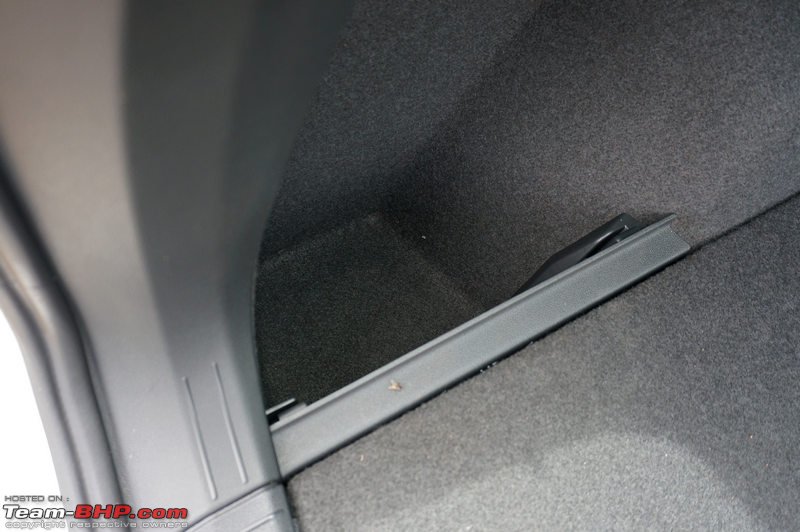 Spare wheel is not an alloy, but a space saver 18" steel rim with a 145/85 tyre wrapped around it!! How we wish that the Germans start providing full-size alloy wheel spares. Tools are neatly stored in a Styrofoam casing around the tyre. The boot floor can be adjusted for 2 levels. To change the height, simply slot the floor board into the lower set of plastic grooves seen in the image:  Powered tail-gate. Party trick = walk up to the Tiguan with the keyfob in your pocket and swing your foot under the rear bumper to open the tailgate! Hands full with bags? No problem. Alternately, the tailgate is opened by simply using the electromagnetic release (unlock car before pressing it), or the button on the keyfob. Tailgate also has a memory function by which you can set how far it should open up. Tailgate is held up by sturdy, well-finished pneumatic struts on both sides:  Press the button on the left and the tailgate will electrically close. Press the "A" button and an orange indicator comes on. Here, simply carry your cargo in both your hands, move away from the tailgate and it will close on its own:  Last edited by GTO : 22nd September 2017 at 12:16. |
| |  (35)
Thanks (35)
Thanks
 |
| The following 35 BHPians Thank Aditya for this useful post: | akshay81, anukritbhargava, Ashutosh, Avikbrio, batladanny, blackwasp, Chethan B G, Col Mehta, deetjohn, dkaile, fluidicjoy, GTO, InControl, Jaggu, Keynote, libranof1987, MadSnapper, mbz180, MVM, neil.jericho, phoenixash, RaghuVis, RavenAvi, Reinhard, RoverX, Simat, SourabhSuresh, sparky@home, sunny29584, uday.ere, vb-saan, Vid6639, Viju, Vik0728, vredesbyrd |
| | #6 |
| Team-BHP Support  | In-Car Entertainment The Tiguan gets a touchscreen infotainment system which offers smartphone connectivity via Android Auto, Apple CarPlay or Mirror Link  . Music is played through 8 speakers (4 tweeters + 4 mid bass) located on the doors. Connectivity is through Bluetooth, USB or Aux-in. A CD / DVD player is housed in the glovebox, but we doubt anyone's ever going to use that. The system does not come with inbuilt navigation, but gets voice recognition & serves as a screen for the reversing camera. Android users won't miss the inbuilt navigation thanks to Android Auto, but iOS users will. . Music is played through 8 speakers (4 tweeters + 4 mid bass) located on the doors. Connectivity is through Bluetooth, USB or Aux-in. A CD / DVD player is housed in the glovebox, but we doubt anyone's ever going to use that. The system does not come with inbuilt navigation, but gets voice recognition & serves as a screen for the reversing camera. Android users won't miss the inbuilt navigation thanks to Android Auto, but iOS users will. 8-inch touchscreen is very easy to operate. Visibility under direct sunlight is average. Response time is fast and the piano black panel looks sweet. Notice the colour icons for our radio stations:  Music is played through 8 speakers (4 mid bass + 4 tweeters):  Each door gets a tweeter. The tweeters help in providing a good high set sound stage so that it doesn't sound like music is playing near your feet:  On the rear doors, the tweeters are placed slightly lower:  Sound settings include the usual 3-band equaliser...  ...and fader / balance adjustments. The sound is clean with a focus on mid to high frequencies. However, the lack of a subwoofer is very apparent. In such a premium-priced SUV, a subwoofer should have been offered. At higher volumes, the speakers start jarring along with the door pads. The system is best played at moderate volumes. Audiophiles will be left wanting:  Pairing with your smartphone is quick & easy using Bluetooth. Cellular audio clarity is excellent:  Voice controls can be used for various functions of the infotainment system. However, these days, manufacturers should not really bother with voice recognition as Android Assistant and Siri are far more advanced & better implemented than the inbuilt ones:  Infotainment system gives an overview of the fuel consumption and...  ...how efficiently you have been driving: 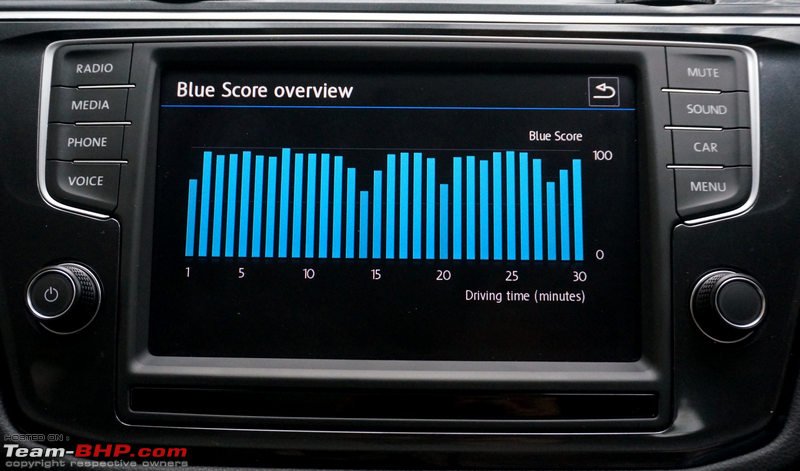 "Blue Trainer" displays your consumption and "Blue Score". Ignore the 4.2 km/l reading - it's because the car was idling during our photoshoot:  It also gives you some tips to reduce fuel consumption. To really know how to improve FE, click here:  Tyre pressures are also displayed on the screen. Recommendations for the tyre pressure are given in brackets. The suggested pressure changes for different modes. Here is the display for the comfort mode...  ...and standard mode. 38 PSI seems quite high for Indian roads. Ride quality will suffer even more (details later):  For carrying passengers and luggage, the rear pressure suggestion is 45 PSI:  Additional fuel consumed by accessory units like the air con is also shown on the screen. Here, it shows how much fuel is being consumed by the air-conditioner:  You can even check the long-term FE:  The climate control system can be adjusted by using the infotainment system, as well as the dedicated dials below. You can even lock the temperature of the rear zone. Only if you unlock it, can the rear passengers change it:  The brightness level of the ambient lighting found on the doors, foot well and roof can be adjusted individually:  You can set the language & system voice (male / female):  Units of measurement for all the parameters can be set based on your preferences:  Convenience features of the ORVMs & wipers:  All these settings can be stored under driver profiles. 3 driver profiles and 1 guest profile are available: 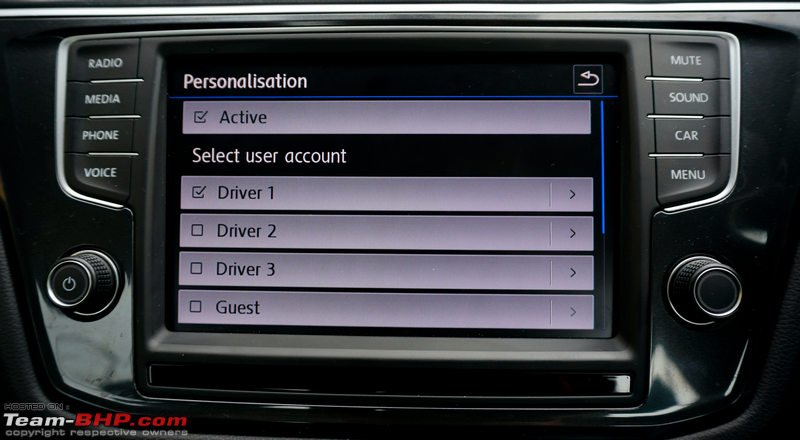 Driver name can be set, and you can even copy the settings over to another profile:  System information shows hardware and software versions. This screen is also used to update the software (see button at the bottom):  17-character VIN & next service details:  The Tiguan gets Android Auto, Mirror-Link and Apple CarPlay as standard. To use any of these, owners have to connect their smartphones to the system via a USB cable: 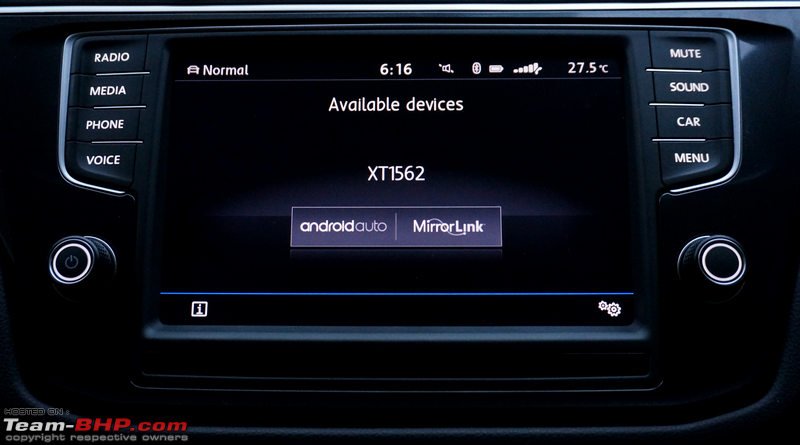 Owners can get directions, make calls and listen to music or audio books through the touchscreen interface:  Navigation through Google Maps is very easy (as always):  Android Auto sure helps in getting real time traffic updates (via Google maps) on the screen. Just one of the many reasons we prefer Android Auto over any inbuilt navigation system:  Whenever the car comes close to another vehicle or object, the park assist system gets activated and this display pops up on the touchscreen. Remember, this car has front parking sensors too:  Rear parking camera display is clear with colour-coded distance demarcations and adaptive guidelines. The camera + parking sensors help greatly while backing up. Sadly, the reversing camera is available only on the Highline variant. The sheer irony - someone who buys a <10 lakh Ameo gets a camera, but not the one who pays 30 lakhs for a Tiguan Comfortline. Where is the sense in that?  System reminds you to take your smartphone with you when you open the driver's door: 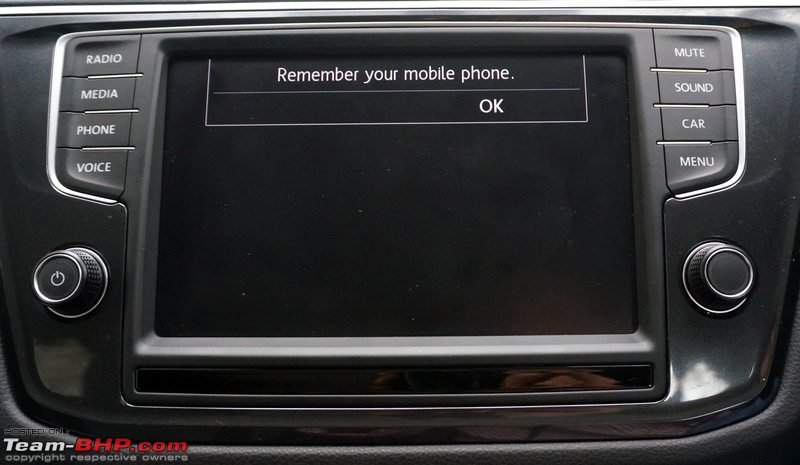 Last edited by GTO : 22nd September 2017 at 12:15. |
| |  (29)
Thanks (29)
Thanks
 |
| The following 29 BHPians Thank Aditya for this useful post: | akshay81, anukritbhargava, Ashutosh, Avikbrio, Col Mehta, dkaile, GTO, hemanth.anand, Jaggu, lemedico, libranof1987, neil.jericho, Obi-Wan, RaghuVis, Rajeevraj, RavenAvi, Reinhard, RoverX, Simat, sparky@home, sunny29584, sunny310c, supertinu, uday.ere, vb-saan, vibbs, Vid6639, vishy76, vredesbyrd |
| | #7 |
| Team-BHP Support  | Driving the 2.0L Diesel  The Tiguan is powered by the familiar 2.0L TDI diesel engine mated to a 7-speed DSG gearbox. This is the only engine & transmission combo available in India. The EA288-codenamed engine is well known in India from the Octavia and new Superb. It is not part of the VW emission scandal, which was for the older EA189 diesel found in the previous-gen Superb and Jetta. Volkswagen has opted to get the Tiguan with the lower state of tune, similar to the lighter Octavia vs the Superb, which is disappointing considering the pricing & kerb weight of the SUV. The Tiguan produces 141 BHP (@ 4,000 rpm), which is significantly lower than the Superb's figure of 174 BHP. When it comes to torque, the Tiguan's motor pumps out 340 Nm (@ 1,750 - 2,750 rpm), which is 20 Nm more than the Octavia, but 10 Nm down on the Superb. Internationally, the Tiguan is also available with a 2.0L TDI engine producing 188 BHP (@ 3,500 - 4,000 rpm) and 400 Nm of torque (@ 1,900 - 3,300 rpm). These figures are on par with the BMWs and Audis, which the Tiguan is targeting, and it would have been nice to get this state of tune in India. We can tell you upfront that the Tiguan's performance is 'adequate', but there is none of that 'wow' factor that you would expect after spending so much money. The Tiguan is a well-built and heavy SUV. It tips the scales at a hefty 1720 kgs! Even the larger Superb is ~150 kilos lighter than this VW. As a result, the power-to-weight ratio isn't great vs the Superb (or even the cheaper Compass). It emphasizes the point that VW should have opted for the higher 188 BHP state of tune over the 141 BHP. On paper, the 141 BHP feels underwhelming. Out on the road, the Tiguan feels peppy enough and performance is acceptable. It is certainly not underpowered, although it's not exceptional either. The engine note is nice - a Jetta owner confirmed that the EA288 sounds sportier. The Tiguan's 7-speed DSG is not the same as the one mated to the VAG TSI petrol engines i.e. the notorious DQ200. This is the newer DQ500 transmission that features a wet clutch (vs the DQ200 dry clutch). This transmission is capable of handling 600 Nm of torque and is compatible with the all-wheel drive system seen in the Tiguan. The reliability of this transmission is *claimed* to be better than the old dry clutch 7-speed DSG. We'll depend on our long-term ownership reports for a verdict on its durability. Until then, our fingers are crossed. Tap the start / stop button whilst the brake pedal is pressed and the Tiguan's motor comes to life. While the diesel clatter is loud on the outside, it's quite silent on the inside. That said, you can still hear the diesel thrum at all times. Overall refinement levels are good and it's only when the revv needle crosses 3,000 rpm that the diesel's thrum is intrusive inside the cabin. Vibrations are well-controlled too. The diesel's torque coupled with the slick DSG feels perfectly tuned for the city. There's negligible turbo lag and power is available from as low as 1,250 rpm. Throttle inputs are sharp and the engine is very revv-happy. Its responsiveness will pleasantly surprise you & power delivery is linear in nature. In the city, you'll notice the gearbox is eager to upshift quickly. Owners will appreciate the smooth & seamless upshifts of this DSG. On your daily drive through rush hour traffic, you'll only need to give the engine light accelerator inputs. If you're easy on the gas pedal, this SUV is a calm commuter and fuel efficiency will be respectable as well. Under most circumstances, the car doesn't warrant a downshift at light - medium throttle inputs as there is adequate torque to pull away. However, if you see a gap that you want to close immediately and floor the accelerator, there is a delay of around a second from the box before it drops a gear (or two) and surges ahead. With DSGs, downshifts are usually not quite as instantaneous as upshifts, especially in D mode. The Tiguan is competent enough on the open road. It's a relaxed cruiser that can happily do three digit speeds all day long. 100 km/h comes up at merely ~1,650 rpm, while 120 km/h is seen at a calm ~1,900 rpm in 7th gear. Such relaxed cruising means minimal engine sound & a longer tank range. Overtaking is easy. Mash the throttle, wait for the transmission to kickdown to a lower gear and you'll see the diesel revving freely to its redline. The mid-range packs a satisfactory punch and the torque on tap makes light work of passing others. Its taller seating position also helps with visibility. On the highway, this engine + gearbox combination truly shines. You simply don’t realise the speeds you’re doing, thanks to the car's behaviour & stability! Expressway performance is of a very tall order. We must mention again though that open road performance is adequate; no owner will complain, but neither will anyone be burning the tarmac up. The Tiguan's DSG features an "S" mode, which is similar in function to other VW cars. "S" mode changes the gearbox's shift points. The gearbox holds onto a gear longer too. One can engage the manual tiptronic mode by moving the gear lever to the right into the tiptronic gate, or by clicking on any of the plastic paddles. Tiptronic works in both "D" & "S" modes. The response time in tiptronic is decent and the DSG holds onto gears till ~5,000 rpm. However, keep in mind that power starts tapering off after 4,500 rpm. One can use this mode to keep the engine in its powerband (at the cost of higher revvs), which can be useful for overtaking maneuvers. Apart from the gearbox's "S" mode, the Tiguan has a host of driving modes, which change the parameters of the engine, gearbox, steering, ESP, adaptive lights and air-con. In addition to the usual Sport and Eco modes, you get an offroad mode and a snow mode. To change between the different modes is easy once you get the hang of it. The Tiguan gets a rotary knob known as the '4Motion Active Control' with 4 modes available - Snow, On-road, Offroad and Offroad Individual. The default mode is the "On-road" mode. When the dial is in the "On-road" position, one can further select between 4 sub-modes, namely Eco, Normal, Sport and Individual. Each mode changes the engine's characteristics, gearbox shift points, air-con operation, steering weight, etc. • Normal mode: This is the default mode you should use for everyday driving. It is a good balance between economy & power. Anytime you need to perform some quick overtaking maneuvers, you can always flick the gear lever in "S" mode for better performance. • Sport mode: Engage Sport mode and you'll feel the throttle to be sharper. The engine feels more responsive in Sport mode for sure. Acceleration seems to be noticeably improved. This is the mode for when you're in the 'mood'. It certainly helps when driving on undivided highways too, where it is necessary to overtake vehicles quickly. For regular city driving however, this mode can feel peaky. The steering also feels heavier than the other modes. The headlights adjust more dynamically here. • Eco mode: Engage Eco and you'll immediately see the air-con blower's level drop down a notch. The climate control doesn't work as hard in Eco mode - it still cools the cabin sufficiently though. Power delivery is lazier, with the throttle response dulled a bit. Additionally, the engine comes with a coasting feature, which works when Eco mode is engaged. Step off the accelerator pedal and the transmission disengages from the engine, with revvs falling below 1,000 rpm. If you touch the brakes, it engages the gearbox again to provide engine braking. Overall, because the engine is reasonably powerful, Eco mode is still useable. It doesn't feel too sluggish and there is sufficient grunt on tap to keep you cruising at higher speeds. When it comes to quick overtaking, you will need Normal or Sport modes. • Individual mode: The driver can choose to adjust the individual parameters such as the steering, drive and air-conditioning, according to his preferences. The Tiguan comes with a convenient 'auto hold' feature which owners will love in the city. While the vehicle is waiting at a signal, the driver can lift his foot off the brake pedal and the vehicle will stay in place. No need to keep the brake pedal continuously pressed. While the Tiguan's engine sound is controlled, wind noise entering the cabin is rather high. Wind noise at 120 km/h was higher than we'd expect in such a premium car. This was disappointing. Volkswagen has equipped the Tiguan with its 4MOTION all-wheel-drive system. As is usually the case with such crossovers, in normal conditions, the system sends power to the front wheels only. If road conditions require more traction, it will send the necessary amount of torque to the rear wheels. The system monitors which of the four wheels has the most traction and is able to send torque to those wheels. If slippery roads make a wheel lose traction, the system hits the brake on that wheel and transfers the remaining power to the other wheels. The AWD will help you when touring remote parts of the country and over the likes of slush, muck & sand. It's no offroader like the Fortuner or Endeavour though. There are 3 terrain modes one can choose from by using the rotary knob on the center console (over and above the on-road mode): • Snow - This should be engaged on icy or snow-covered roads. It provides better accelerator sensitivity in these conditions. "S" mode is disabled. • Offroad - Accelerator sensitivity is adjusted for rough terrain and unpaved roads. Engine braking is always available and hill start assist + hill descent control are switched on. Acceleration is restricted while driving downhill and it is not possible to shift to "S" mode. • Offroad individual - All the adjustments that are made under the offroad mode are incorporated in this mode. Additionally, the driver can customize certain parameters to his liking (explanatory pic toward the end of this post). Transversely mounted 2.0L TDI engine fills up the bay completely:  141 BHP & 340 Nm of torque. Should've had more at this price:  Insulation sheet under the hood. Bonnet is held up by a single pneumatic strut: 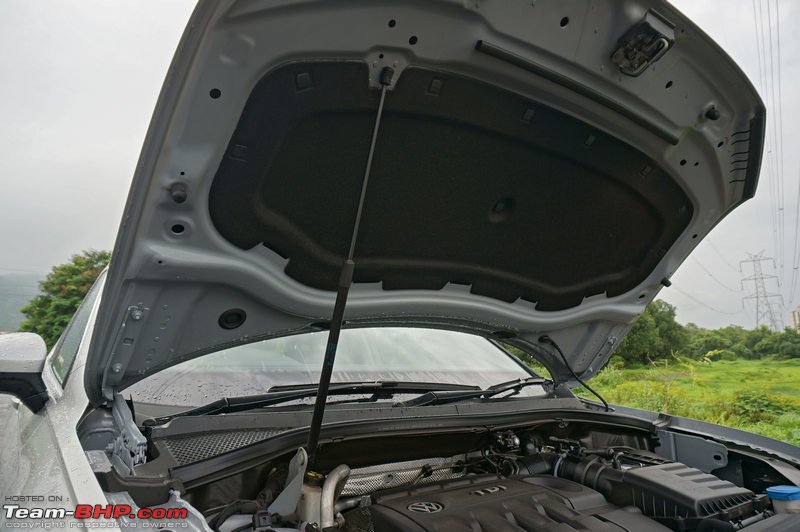 The ECU & fuse box:  Firewall gets ample insulation:  DSG gear lever is the same as other Volkswagen cars (including the far cheaper Polo GT). Should have been different:  Gear selector has a leather boot. Notice the 3 blanks above the parking sensor button? That's too many in a 30 lakh car! Internationally, these serve as buttons for the auto park and engine start / stop systems:  The selected gear / mode is displayed on the upper right corner of the MID:  Orange light on the knob does not come on if the car is in normal mode. Engage any other mode (offroad, sport, etc.) and it comes on:  The touchscreen displays the selected drive mode, along with a short description of it:  The 'offroad individual' mode allows you a lot of customisation. You can individually tune the different parameters:  The selected drive mode is displayed on the MID as well:  When the car is coasting in ECO mode, the system will tell you about it:  Button to turn traction control off is located on the right of the gear shifter. It is not backlit:  Traction control can be disabled in any mode:  The auto-hold and electronic parking brake buttons. The parking brake is automatically disengaged when you engage a gear:  Green "P" indicator on the MID appears whenever 'auto hold' is engaged:  Last edited by Aditya : 13th December 2017 at 16:07. |
| |  (33)
Thanks (33)
Thanks
 |
| The following 33 BHPians Thank Aditya for this useful post: | akshay81, anukritbhargava, Ashutosh, Avikbrio, AYP, blackwasp, Chethan B G, Col Mehta, deetjohn, Flyer, GTO, hemanth.anand, Jaggu, Keynote, libranof1987, MVM, neil.jericho, Nikhilb2008, Obi-Wan, phoenixash, RaghuVis, RavenAvi, Reinhard, Simat, Simhi, sparky@home, sunny29584, uday.ere, Varun_HexaGuy, vb-saan, vibbs, Vid6639, Vik0728 |
| | #8 |
| Team-BHP Support  | Ride & Handling The Tiguan uses a MacPherson strut suspension up front and a multi-link setup at the rear. The suspension feels too firm for Indian conditions. While owners who drive themselves might find the ride acceptable (it's better at the front), those sitting at the rear will definitely not be comfortable. They will complain. On the back seat, road imperfections come in easily at low speeds and on broken roads, it can get bone-jarring. Volkswagen should have softened it more for our kind of roads; we don't have blemish-free tarmac like Europe! You can also hear some suspension 'thuds' in the cabin. I must add that the poor ride quality is probably accentuated by the 18" rims and 235/55 profile tyres. The lower Comfortline spec with 17" wheels and 215/65 tyres should offer a more compliant ride due to its taller tyre sidewall. Won't be a world of difference though. As the speedometer climbs, ride quality does get better, but it still cannot be termed plush. As long as the expressway is smooth, there are no issues. Big & sharp bumps easily make their presence felt inside the cabin though. It's nowhere near the magic carpet ride offered by something like the Renault Duster. There is no comparison. For an SUV, the Tiguan exhibits good handling characteristics. Guess the taut suspension helps here. Grip levels from the 235 mm Hankook tyres are excellent, with the Tiguan holding her line through the curves smartly. Corner harder and there is some body roll felt, but it's never excessive. The dynamics are typically German and certainly superior to its competitors. The car's high-speed stability is excellent and it feels damn composed at triple digit speeds. The Tiguan masks silly speeds with ease. While the electric power steering is accurate and weighs up at highway speeds (although not as much as enthusiasts would like), it offers very little feel and feedback. On the positive side, it's light at city & parking speeds. This, along with the delightful DSG gearshifts and the relatively urban-friendly dimensions (vs an Endeavour or Fortuner), makes the Tiguan easier to drive in the city. Surprisingly, the Tiguan has a huge turning radius of 5.75m! This is comparable to the Fortuner's 5.8 m - now that's a much larger car. Expect to make more 3-point turns than necessary in the city. The laden ground clearance of 149 mm appears to be adequate. While this figure sounds rather less on paper, it is the new ARAI rule of measuring ground clearance with load. A VW engineer stated that the unladen ground clearance is "in the region of 200 mm". We took the car off the road on a couple of occasions to shoot photos and it didn't scrape its undercarriage anywhere. The Tiguan underbody is also well protected with VW's stone protection package. Like other cars in its segment, the Tiguan is equipped with disc brakes all round. The brakes are top class. The car had no problems stopping in a straight line, even when we slammed on the brake pedal at speed. Last edited by GTO : 22nd September 2017 at 12:14. |
| |  (25)
Thanks (25)
Thanks
 |
| The following 25 BHPians Thank Aditya for this useful post: | anukritbhargava, Avikbrio, Col Mehta, deetjohn, Flyer, GTO, Jaggu, Keynote, lancer_rit, libranof1987, neil.jericho, Obi-Wan, phoenixash, RaghuVis, RavenAvi, Reinhard, Simat, Simhi, sparky@home, timuseravan, Varun_HexaGuy, vb-saan, VeluM, vibbs, Vid6639 |
| | #9 |
| Team-BHP Support  | Other Points Locally assembled at Aurangabad (Maharashtra). Available in five colours = Tungsten Silver, Atlantic Blue, Deep Black, Oryx White and Indium Grey. Two variants = Comfortline and Highline. Difference between the on-road prices of the Comfortline and Highline is Rs. 3.83 lakhs (Delhi). The Comfortline has all the necessary features, making it a sensible purchase if you are pressed for $$$$. The features missing include LED tail-lamps, panoramic sunroof, ambient lighting (except the footwells), chrome and grey inserts on the bumpers, engine start/stop button, "easy open" tailgate with one-touch closing, self-sealing tyres, 18" rims (we prefer the 17s) and reverse parking camera. Comfortline gets silver inserts on the dashboard & doorpads (instead of the glossy grey of our test car). Healthy fuel tank capacity = 71 liters. That's larger than the Jeep Compass (60 liters) & Hyundai Tucson (62 liters). ARAI fuel efficiency rating = 17.06 km/l. Service interval = 1 year / 15,000 km. Standard warranty of 2 years / unlimited km. Extended warranty for another 2 years available (and strongly recommended in European cars). 3 year paint warranty & 12 year anti-corrosion perforation warranty is standard. 2 years roadside assistance is standard. Owners can purchase extensions for 1 or 2 years. Awarded a '5-star safety rating' by the Euro NCAP  . . Yep, the doors auto-lock at 15 km/h as you move along. They also auto-unlock when you switch the car off. The auto wipers & auto-dimming IRVM have no button that needs to be pressed to activate the features. They are on all the time! We love it this way. Remember we spoke of the tailgate's memory function? Here's how to set it up: a) Stop the tailgate in the desired position by pressing the open / close button on the tailgate. b) Press and hold the open / close button till the hazard lights blink. c) You will hear a beep when the memory function is set for that position. d) Next time the tailgate opens, it will stop in this position. BHPian mm83 states that the new Tiguans have been updated with a full touchscreen head-unit (link to post). Disclaimer: Volkswagen invited Team-BHP for the Tiguan test-drive. They covered all the travel expenses for this driving event. Last edited by GTO : 22nd September 2017 at 12:13. |
| |  (32)
Thanks (32)
Thanks
 |
| The following 32 BHPians Thank Aditya for this useful post: | adityan27, akshay81, anukritbhargava, Avikbrio, blackwasp, Chethan B G, Col Mehta, deetjohn, Flyer, GTO, Jaggu, Keynote, lancer_rit, libranof1987, MVM, neil.jericho, Obi-Wan, phoenixash, RaghuVis, Rajeevraj, RavenAvi, Reinhard, Simat, sourabhzen, sparky@home, sri_tesla, supertinu, uday.ere, vb-saan, VeluM, Vid6639, Vik0728 |
| | #10 |
| Team-BHP Support  | The Smaller yet Significant Things Foglamps double up as cornering lights. Turn the wheel to one side and the foglamp on that side switches on automatically: 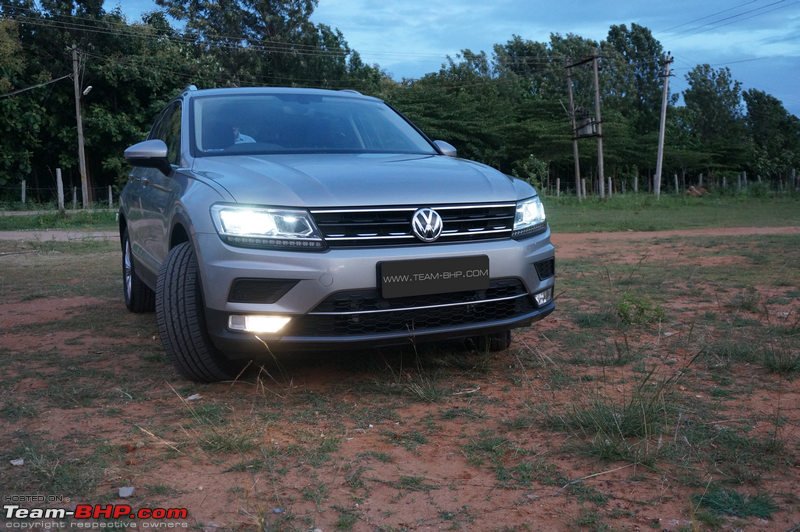 To access the keyhole (say, when your smartkey's battery goes kaput), you need to pry this portion of the door handle out from underneath (via the small notch). Someone's carelessness has already damaged it: 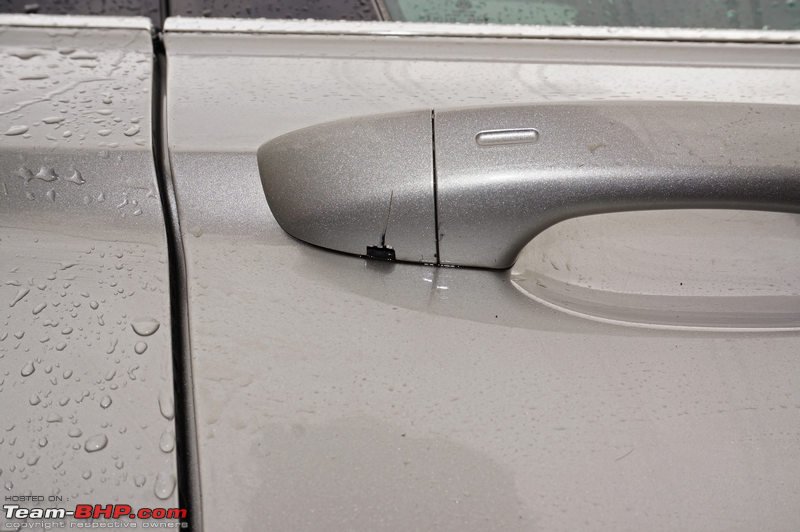 Automatic rain-sensing wipers are standard on both variants! Sensor located on the center of the windshield:  ORVMs house useful puddle lamps underneath:  Fuel flap is linked to the central locking system. Push the flap gently to open it. Multiple 'DIESEL' markings ensure no pump attendant will fill the wrong fuel in your Tiguan:  Recommended tyre pressure ratings. The rears seem to be too high, will affect ride quality further. Reminds us of how the earlier Passat had a 40+ PSI rating (which no owner followed):  The inner rubber beading (on the body & pillars) is of excellent quality. Still, wind noise is high:  Really cool (and standard with most VWs) - the driver can see the ORVM blinker from inside:  ORVMs have two small fins that are visible from the inside:  Rear view mirror is frameless - looks incredibly classy: 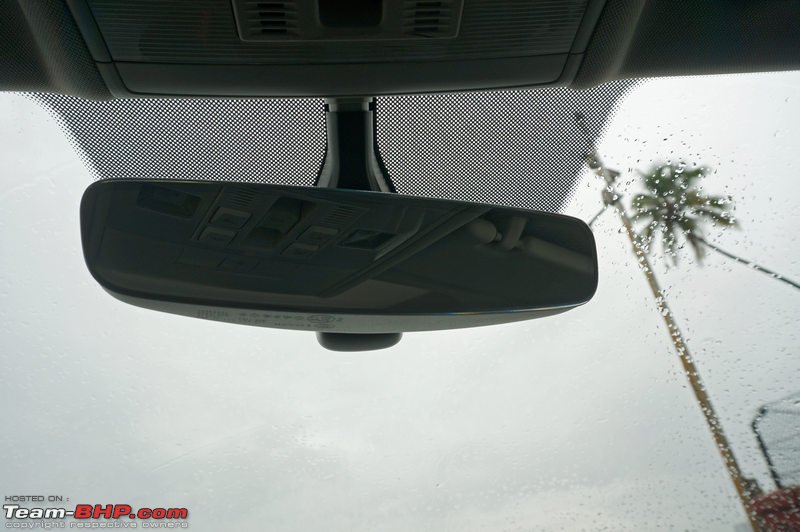 71L fuel tank is well-sized. Lots of underbody protection provided:  Auto-levelling LED headlamps are bright and do a great job of lighting up the road ahead, but... 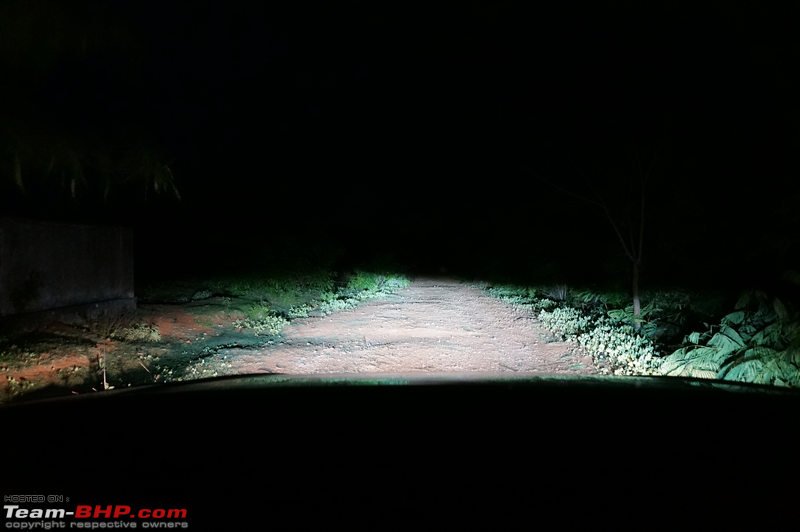 ...the high beam's throw was just average:  Sweet white LED ambient lighting along the length of the sunroof...  ...on all four doors (including the door handles)...  ...the scuff plates of the front door sills...  ...and both footwells:  Interior buttons are backlit in white. No bright oranges, reds or greens by VW:  Only the left seatbelt buckle has a soft felt-lining to prevent scratches when rubbing against the center console. The driver doesn't need it as his seatbelt will always be buckled (and hence, away from the center console):  Pink (yikes!!!) OBD port is located below the dashboard (in the driver's footwell):  Plastic buttons hold the floor mat in place. They are provided on the passenger side as well:  Flippy key, with boot release button in the middle. Long-press the unlock button and the windows roll down automatically. Similarly, long-press the lock button and the windows go up automatically:  Faux leather covers up the gap between the dashboard and steering wheel:  The Tiguan gets VW's pedestrian-safe Reactive hood. The bonnet will tilt forwards in a frontal collision to dampen the impact for a pedestrian hit between 25-55 km/hr. Volkswagen claims this has a cushioning effect and reduces the chances of serious injury to the pedestrian: 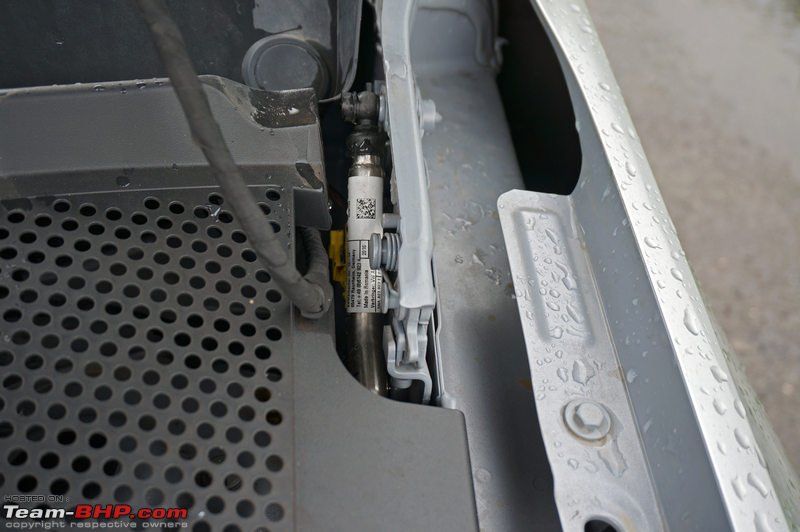 17-digit VIN found on the lower left side of the windshield:  Silver valve caps from Alligator Ventilfabrik GmbH:  |
| |  (57)
Thanks (57)
Thanks
 |
| The following 57 BHPians Thank Aditya for this useful post: | adityan27, akshay81, anukritbhargava, Ashutosh, AYP, BigBrad, Biohazard, blackwasp, cars_etcetera, Chethan B G, Col Mehta, daretodream, deetjohn, djay434, dkaile, el lobo 6061, fluidicjoy, Flyer, GTO, hemanth.anand, ike, Jaggu, jalajprakash, k88k, Keynote, kpower11, kutts, mazda4life, mug:mush, MVM, Nair.V8, neil.jericho, Obi-Wan, OrangeCar, phoenixash, psispace, Raghav07, RaghuVis, Rajeevraj, RavenAvi, Reinhard, RoverX, sai_ace, Scorpion 10, sharktale, Simat, Simhi, sparky@home, sunny29584, supertinu, The Rationalist, theexperthand, uday.ere, Varun_HexaGuy, vb-saan, VeluM, Vid6639 |
| | #11 |
| Team-BHP Support  | Re: Volkswagen Tiguan : Official Review Thread moved from the Assembly Line to the Official Reviews Section. Thanks for sharing, rating thread 5 stars for the detail! |
| |  (6)
Thanks (6)
Thanks
 |
| The following 6 BHPians Thank GTO for this useful post: | Aditya, anukritbhargava, MVM, sparky@home, vb-saan, Vid6639 |
| |
| | #12 |
| Distinguished - BHPian  Join Date: Aug 2011 Location: Bangalore
Posts: 4,606
Thanked: 17,681 Times
| Re: Volkswagen Tiguan : Official Review Brilliant Review Aditya and Jaggu. Thank you for sharing. Especially love the Team-Bhp reviews of VAG group cars. These cars typically have a lot of small but significant things and the reviews in usual Team-Bhp fashion pick up most of these things. Makes for a fascinating read.  Love this car. Tad too expensive in my opinion. But inspite of the price, seems to be generating a good amount of interest and seeing pretty decent sales numbers. Expecting it to become a nice VFM pre-owned buy 2-3 years down the line. Would be very interested.  A little surprised to see an option to turn off the passenger airbag. Last edited by Rajeevraj : 22nd September 2017 at 13:34. |
| |  (16)
Thanks (16)
Thanks
 |
| The following 16 BHPians Thank Rajeevraj for this useful post: | Aditya, Aficionados, Ashutosh, bhavik.1991, Biohazard, GTO, Ithaca, Jaggu, Keynote, MVM, RavenAvi, Reinhard, The Brutailer, The Rationalist, vb-saan, Vid6639 |
| | #13 |
| BHPian | Re: Volkswagen Tiguan : Official Review |
| |  (9)
Thanks (9)
Thanks
 |
| The following 9 BHPians Thank nanu28 for this useful post: | Aditya, Biohazard, GTO, Jaggu, MVM, RavenAvi, romil.shroff, The Brutailer, vb-saan |
| | #14 |
| Senior - BHPian | Re: Volkswagen Tiguan : Official Review The summary says the car is priced at least 2 lakh on higher side. Even though a very like-able car with clean lines and top quality stuff, great interiors and features, I really think this car is at least 5-7 lakh more than that it should have been priced in India. At 35 Lakh OTR (roughly) in Mumbai, there are so so many other options to choose from that the Tiguan will always end up at the end of the list. VW should not waste their time on such launches, even though it keeps them in the eyes of the customers. They would be better off by bringing in their newer Jetta's and Passat's, and update their bread and butter models Polo & Vento. |
| |  (6)
Thanks (6)
Thanks
 |
| The following 6 BHPians Thank vinit.merchant for this useful post: | Aditya, GTO, Jaggu, MVM, RavenAvi, vinayrathore |
| | #15 |
| BHPian Join Date: Mar 2013 Location: KOL-DEL-LKO
Posts: 719
Thanked: 3,510 Times
| Re: Volkswagen Tiguan : Official Review Great review mods. The price does seem a bit high. Especially when see the exterior styling. Somehow, the exterior reminds of the SUVs from the 90's. I like understated clean lines but this one is too boxy. IMHO, Fortuner or Endeavour look much better in comparison. |
| |  (6)
Thanks (6)
Thanks
 |
| The following 6 BHPians Thank PapaBravo for this useful post: | Aditya, GTO, Jaggu, MVM, RavenAvi, vishy76 |
 |



